How To Grow Your Network on LinkedIn: 9 Strategies For 2025
Contents
Networking is a crucial aspect of business and career growth.
No matter if you’re:
- a sales rep looking to generate sales,
- a recruiter looking for the next rockstar hire,
- a student looking for an internship,
- or a job seeker looking for a career change,
your success lies in who you know and who knows you.
This article aims to help you learn how to network effectively and reach out to someone on LinkedIn to boost your business or career.
In this article we’ll cover:
- Why Should You Network On LinkedIn?
- Why LinkedIn is Essential for Networking
- How To Network On LinkedIn
- What to Avoid When Networking on LinkedIn
Why Should You Network On LinkedIn?
Business networking is about making and keeping professional connections to help each other succeed. LinkedIn is a goldmine for business networking, with over 1 billion users in more than 200 countries.

It is by far the best social networking platform to:
- Generate leads and build your brand
- Boost your career
- Find a job or internship
- Recruit new employees
1. Generate Leads And Build Your Brand
Lead generation is the process of identifying and attracting potential customers who may be interested in your company’s products or services.
Lead generation aims to convert leads into paying customers, making it a crucial component of any business’s digital marketing and sales campaigns.
For your lead generation to be impactful, you must meet your potential customers where they are and connect with them on common ground.
LinkedIn lead generation should be one of the primary tools in your arsenal if you’re a marketer or sales rep.
Most LinkedIn users use the platform for business, as it makes it easy to acquire qualified prospects and turn them into paying customers.
In the early days, when Evaboot was just a piece of code on my co-founder’s laptop, we used smart LinkedIn networking to quickly gain 300 likes, 500 comments, and 150 calls.
These interactions filled our calendars with interviews and helped us understand what LinkedIn users needed.
This led to the birth of Evaboot, a powerful tool for LinkedIn networking.
Today, it’s proof that intelligent networking can lead to big success.
We learned that manually cleaning data from sales navigator exports can take hours.
So, we developed Evaboot, which exports and cleans your lead lists in minutes, not hours.
Today, we use Evaboot ourselves and still save a lot of time.
2. Boost Your Career
Networking on LinkedIn can help you discover new employment opportunities.
It can also help you learn new skills, gain insights, and get referrals.
According to LinkedIn, 70% of people get hired at companies where they have a connection.

That’s not all.
Survey results show that 85% of critical jobs are filled via networking.
When I worked in my job before I developed Evaboot, I turned to LinkedIn to network with professionals in my field, engage in meaningful conversations, and showcase my skills.
3. Find a Job or Internship
Growing your LinkedIn network makes finding job or internship opportunities easier, especially those not publicly advertised.
You can also use your network to find mentors, sponsors, and advocates to support your career development.
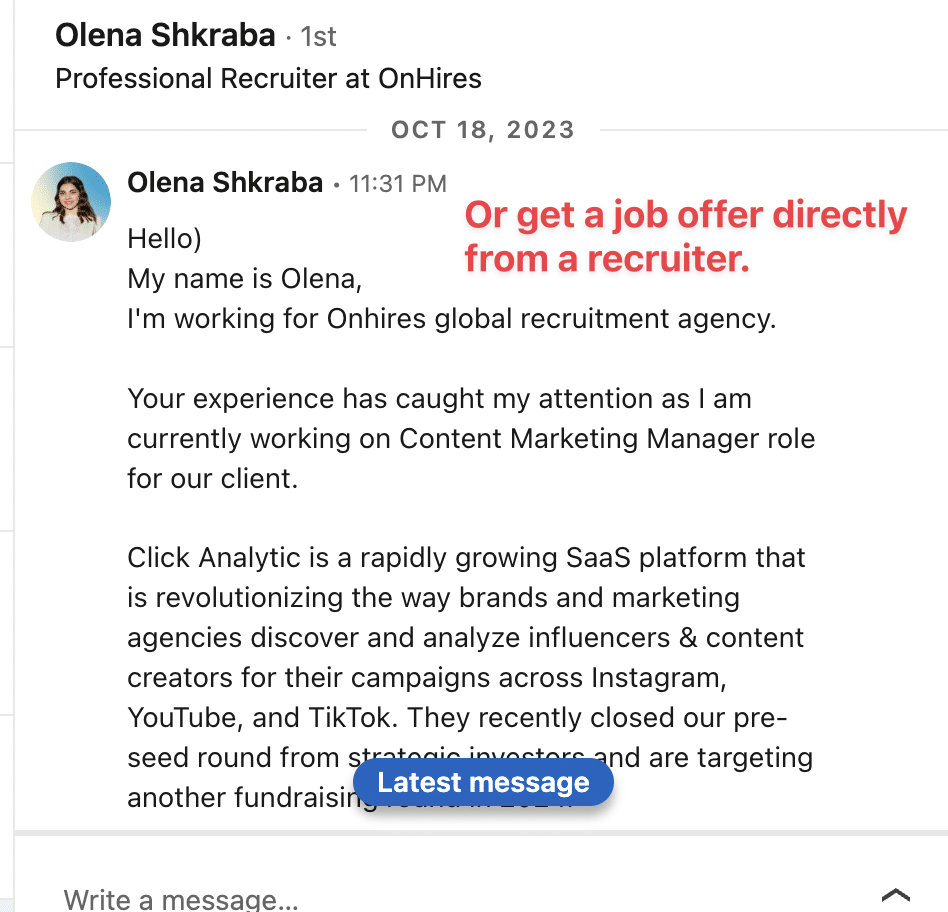
While studying at a Business School for my Master of Science in Entrepreneurship, I leveraged LinkedIn as a powerful networking tool to get a job interview.
In 2017, I secured an internship through my LinkedIn connections, which ultimately evolved into my first job in the field.
With the right strategy, you have an edge over other candidates in the job market, as the platform makes your job search much more accessible.
4. Recruit New Employees
Recruitment is a critical function of human resource management involving identifying, attracting, and selecting qualified individuals to fill job vacancies within an organization.
Knowing how to network on LinkedIn makes this aspect of business growth easy. You can use the platform to attract potential candidates.

This method speeds up the recruitment process while ensuring you get candidates who will add value to your organization.
At Evaboot, we use LinkedIn to build our team by connecting with professionals who share our vision and skills.
We build candidate lists with LinkedIn search and export them to a CSV file using Evaboot. We then upload the cleaned data to an applicant tracking system, saving us work hours.
Why LinkedIn is Essential for Networking
LinkedIn is not just a social network but a powerful tool for advancing your professional goals.
If you’re in sales, you can leverage the platform’s targeted search and messaging features to identify and connect with prospective clients or partners.
You can create a compelling digital resume to help further your career, connect with peers and industry leaders, and explore job opportunities across 55 million companies.
‘Plus, you can upskill using the 1000+ LinkedIn Learning Courses designed to help you become even more effective in your professional roles.
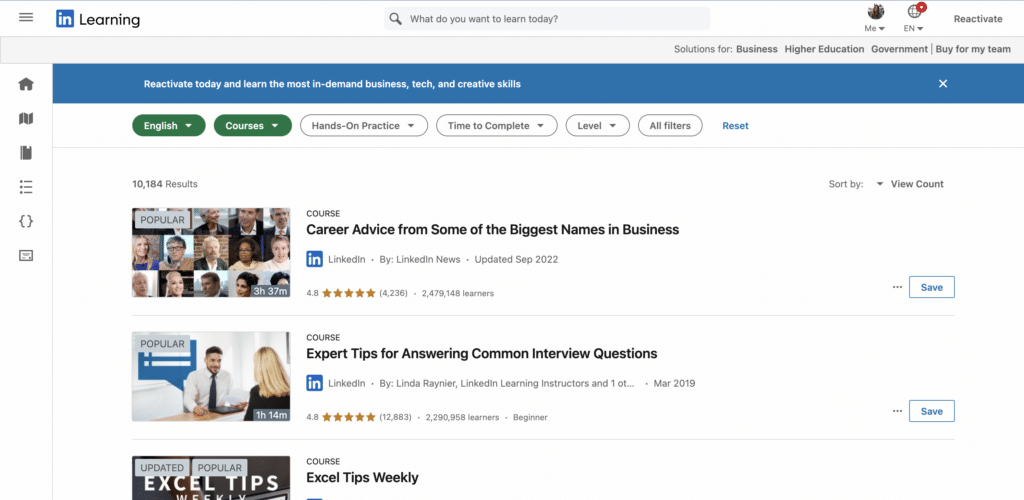
As a recruiter, you have a massive talent pool you can easily sift through using advanced search criteria to find the perfect candidates for your job openings.
LinkedIn was also a small StartUp like Evaboot and began in Reid Hofmann’s living room in 2002. It now offers profound benefits for professional networking:
- Global reach in more than 200 countries
- Up-to-date profiles as users update their profiles by themselves
- Targeted networking and advertising
- Professional endorsements
- Content sharing
- Groups and communities
- Event participation
- Sales and recruitment synergy
- Data-driven insights
- Automation opportunities
Dealing with outdated B2B data and encountering changed contact persons at companies was a major source of frustration and disappointment.
At Evaboot, we think LinkedIn users must update their profiles.
Traditional B2B databases are updated by staff, here, everyone keeps their information current.
LinkedIn is the most trustworthy source for up-to-date B2B data and the must-have networking tool for your business and professional growth.
How To Network On LinkedIn
To successfully network on LinkedIn:
- Update and optimize your profile
- Be present
- Leverage your existing contacts
- Join LinkedIn groups
- Join LinkedIn events
- Filter the right people
- Send personalized connection requests
- Use automation to get more LinkedIn connections
- Use email to connect
1. Update and optimize your profile
Your LinkedIn profile and your LinkedIn profile URL dynamically represent your professional identity, skills, achievements, and qualifications.
It is a digital resume and a powerful tool for networking, driving business growth, recruiting talent, and career advancement.
Add a professional headshot, a profile picture, update your LinkedIn profile to to maximize your presence on the platform and showcase your expertise.
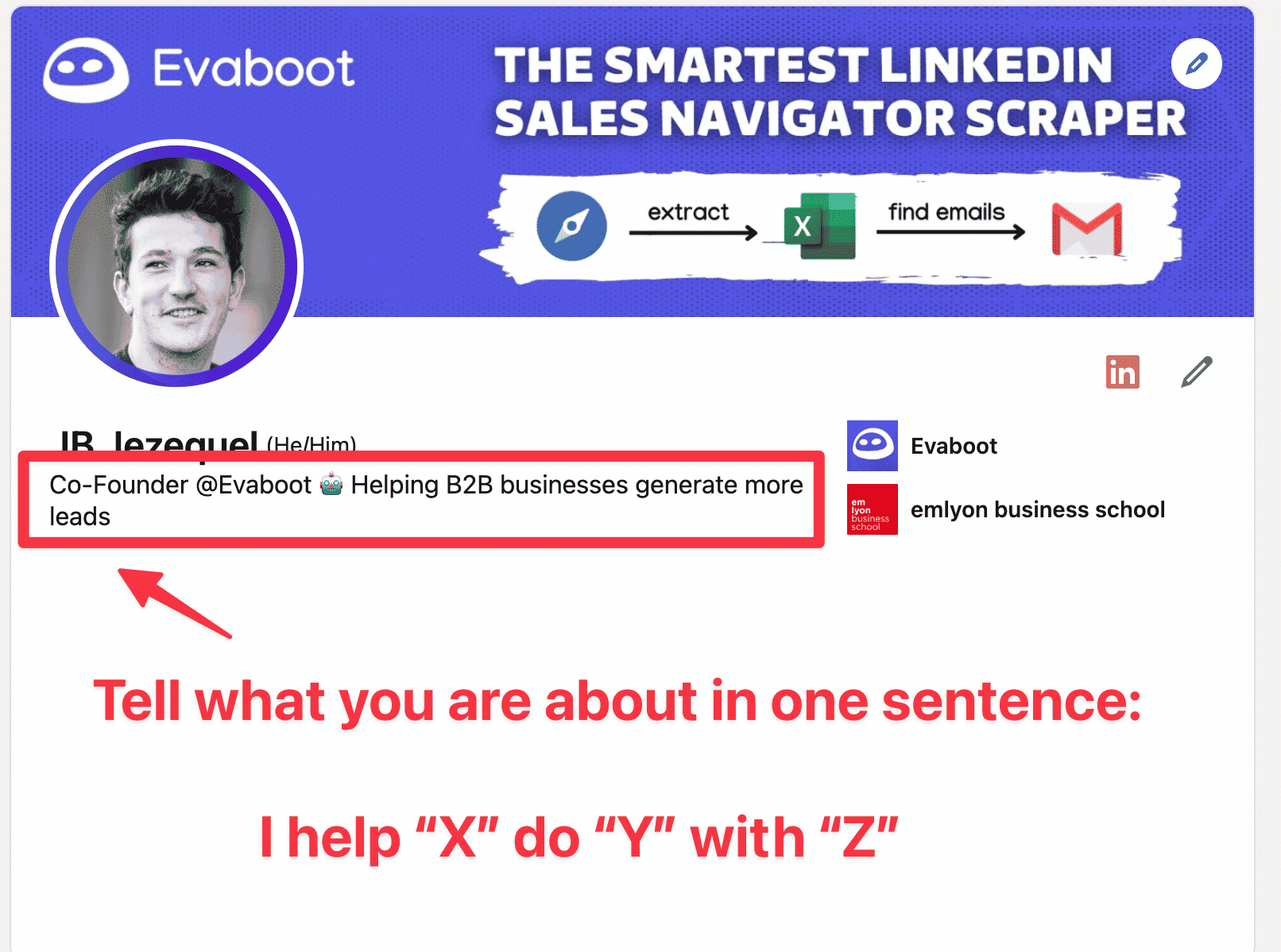
Even as a student, you have more experience than you think.
Think broadly about all your experiences, including summer jobs, unpaid internships, volunteer work, and student organizations.
All these carry weight and can be added to your LinkedIn profile.
You never know what might catch someone’s eye.

You can also beef up your qualifications by taking online courses and getting certifications in your niche. This will earn you extra points and show you’re highly skilled and motivated.
As a sales rep, your optimized LinkedIn profile can be the difference between average sales and record-breaking numbers.
Check out my profile and see how I leveraged it to build a 7-figure software startup in 2 years.
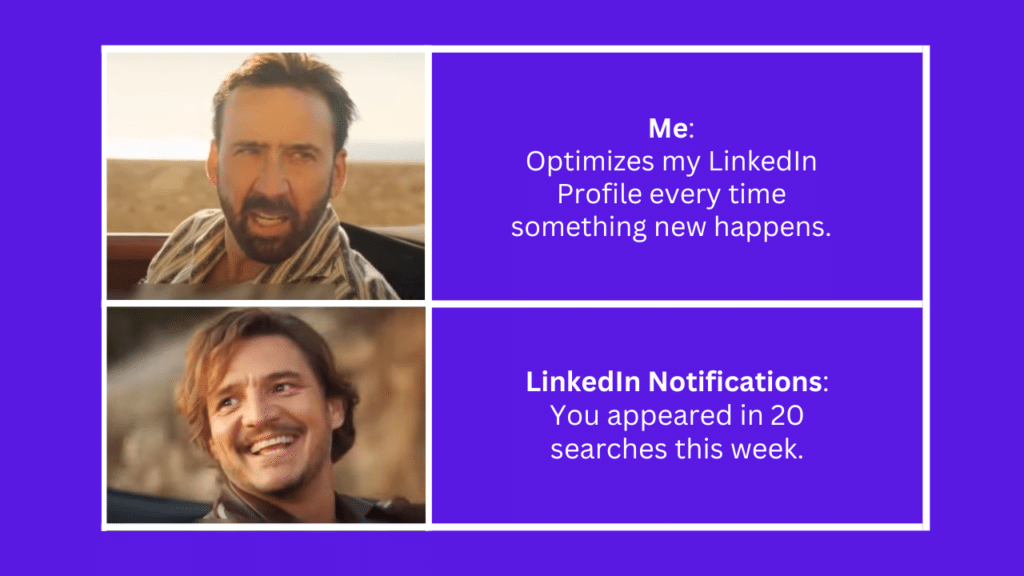
Here are 6 tips for optimizing your LinkedIn profile:
- Demonstrate your skills
- Ask for Endorsements
- Ask for Recommendations
- Give Recommendations
- Optimize your profile for LinkedIn search
- Create a LinkedIn company page
1. Demonstrate Your Skills
LinkedIn makes it easy to show prospective employers or clients your skills and abilities. Here are a few tips for doing just that:
- Use a comprehensive headline
- Craft a compelling LinkedIn summary
- Detail your work experience
- Add licenses and certificates
In our outreach efforts at Evaboot, we focus on identifying potential clients’ or team members’ skills and effectively leveraging those skills to build meaningful connections.

If you need to upskill and add more certificates to your profile, consider completing a few courses on LinkedIn Learning.
LinkedIn Learning is an online learning platform owned by LinkedIn and offers a wide range of courses and video tutorials covering various subjects. These primarily focus on professional and career development.
Once you’ve earned your certificate, LinkedIn makes it easy to demonstrate your licenses and certifications. To do that:
1. Click on the Add Profile Section button.

Doing so will open a window with many options for beefing up your profile.
2. Select Recommended > Add licenses and certifications:
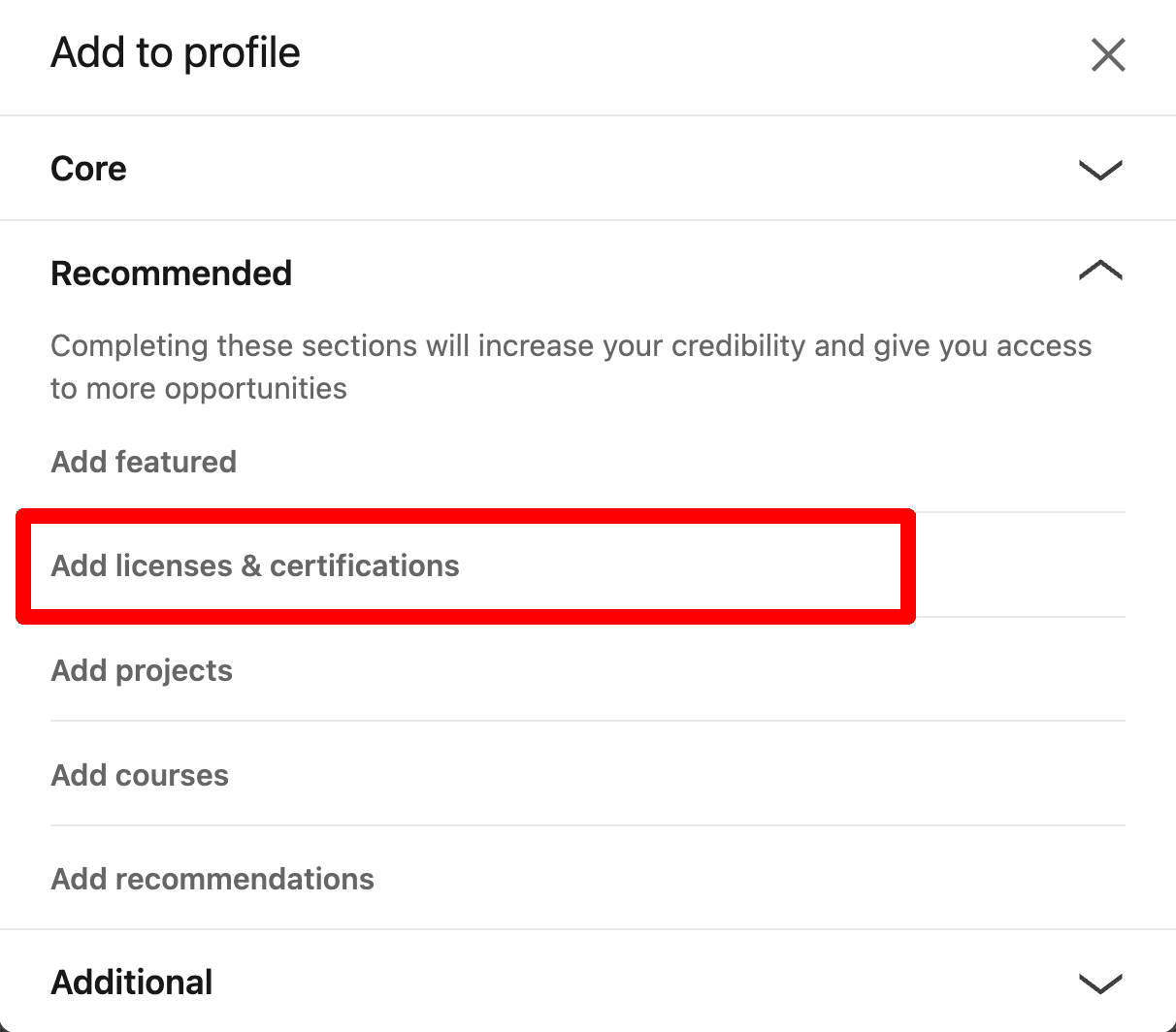
3. Clicking on Add Licenses and Certifications will open a form where you must fill in your certification details.
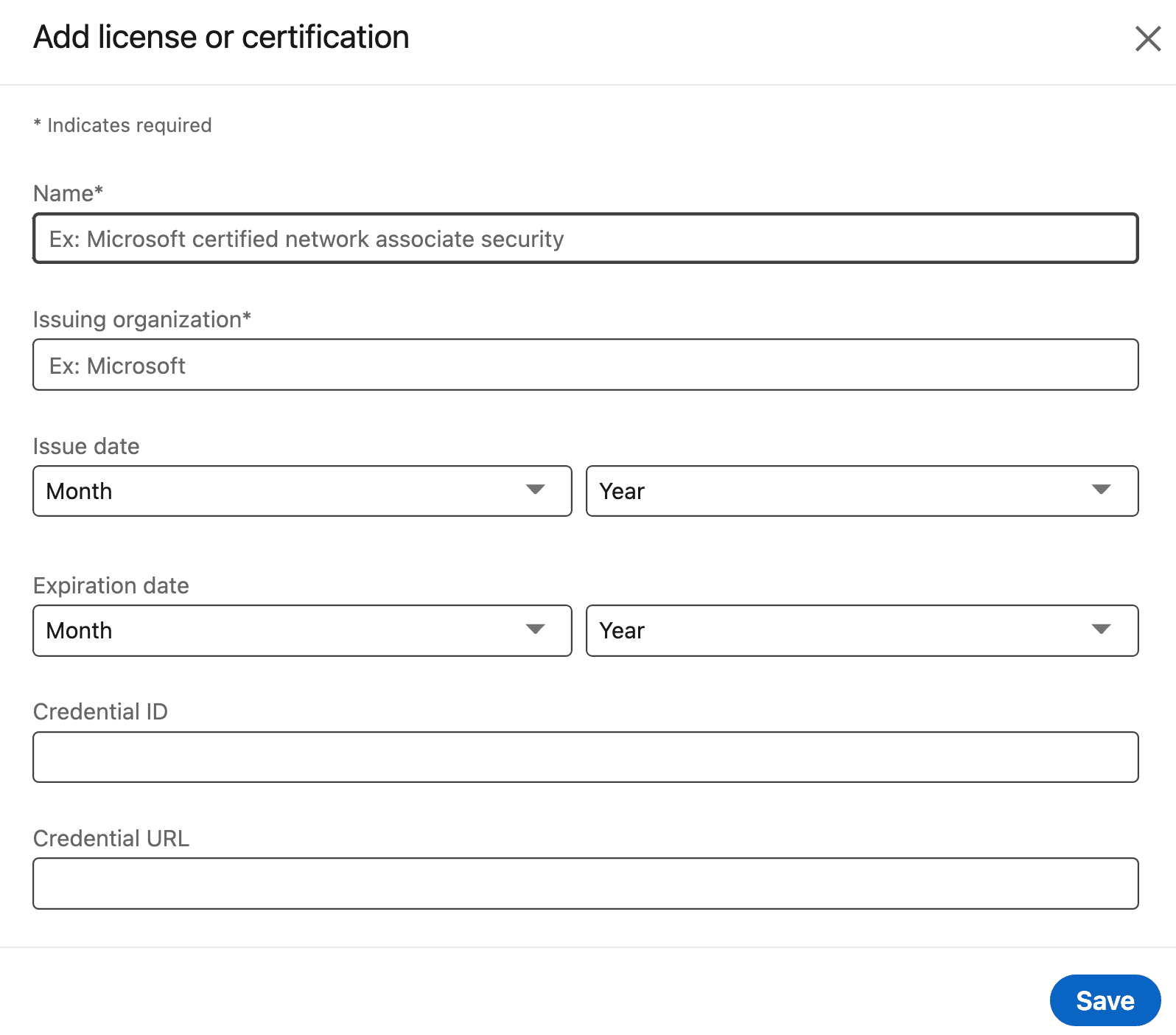
Click save, and your certifications will be displayed on your profile.
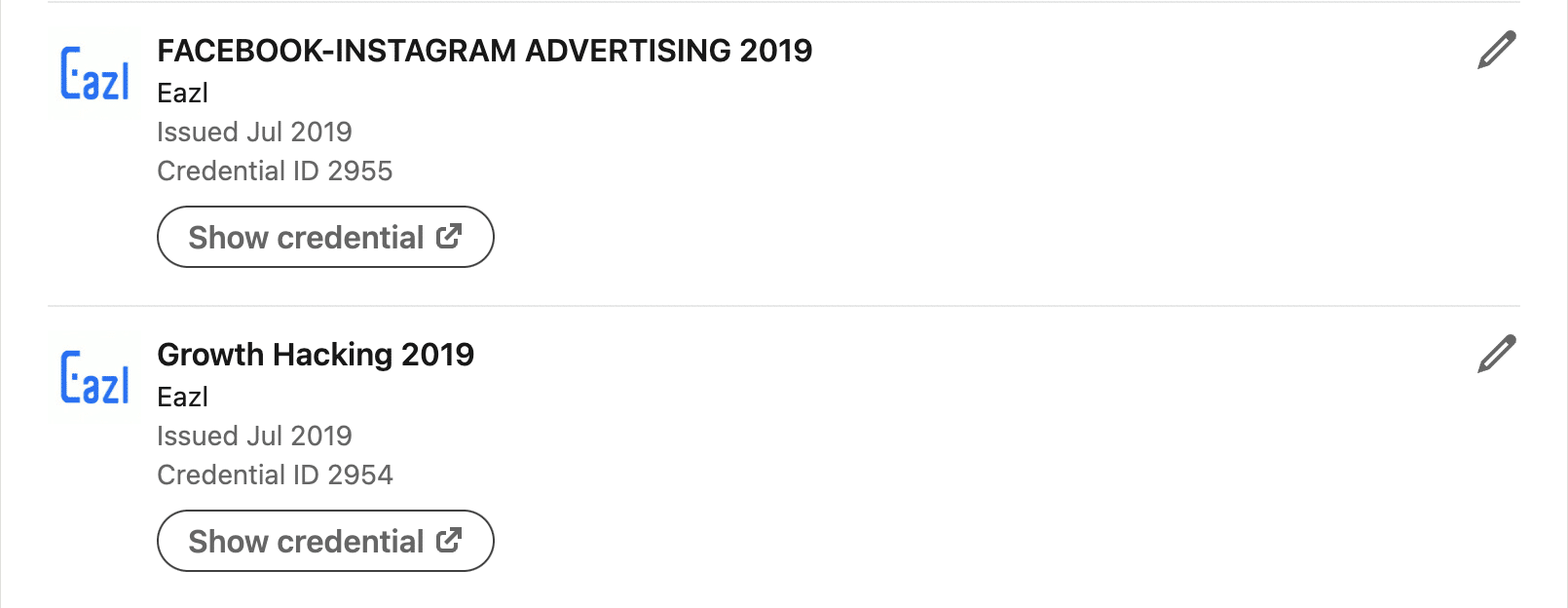
This helps verify all certifications and licenses displayed in a LinkedIn profile.
2. Ask for Endorsements
LinkedIn Endorsements is a feature on LinkedIn that allows members to validate and vouch for the skills and expertise of their connections.
Endorsements are a way for your professional contacts to affirm that you possess the skills or experience you have displayed on your LinkedIn profile.
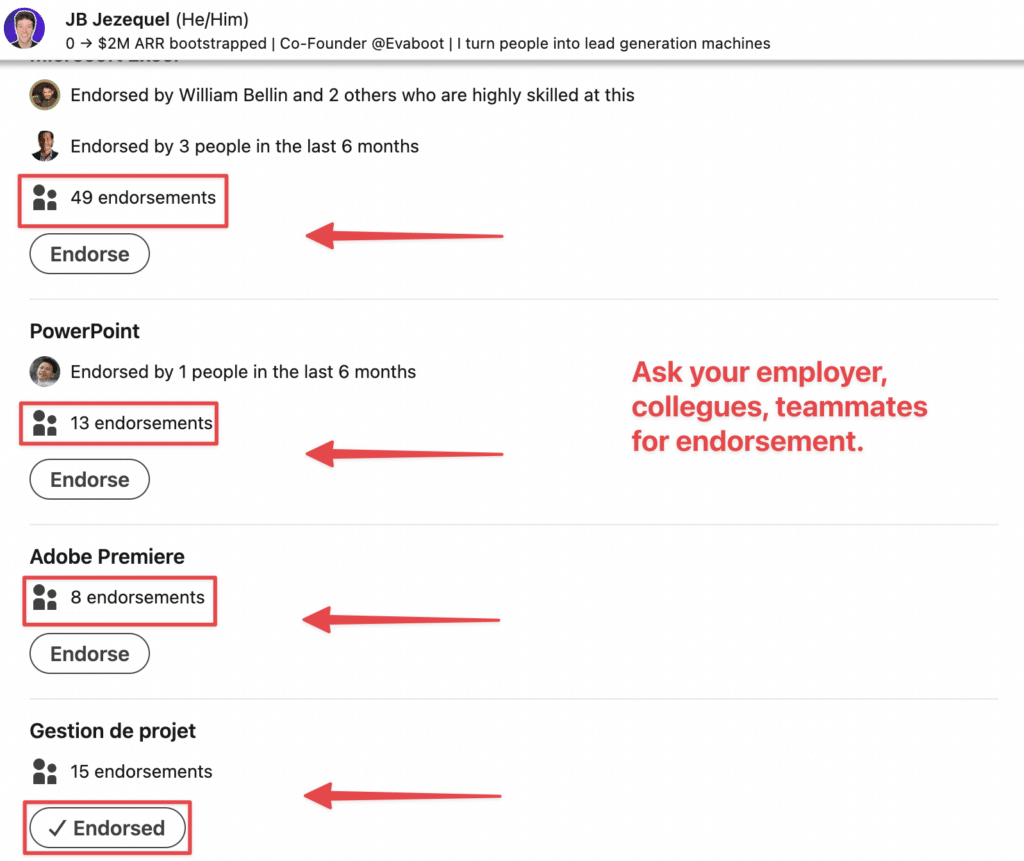
Essentially, they serve as social proof and can enhance your credibility and visibility on LinkedIn.
The easiest way to get endorsements is to ask for them. Contact past employers or clients and ask them to endorse you.
Follow these tips when asking for endorsements:
- Be Specific: Specify desired skills.
- Personalize Message: Avoid defaults.
- Endorse Others: Show goodwill.
- Offer Reciprocity: Suggest mutual endorsement.
- Thank Endorsers: Always show appreciation.
3. Ask for Recommendations
LinkedIn recommendations are written testimonials from professional connections to vouch for your skills, work, and character.
Like endorsements, they are a form of social proof. They provide credibility and validation of your qualifications to potential employers, clients, colleagues, and other LinkedIn users.

You can request other users to recommend you.
To ask for a LinkedIn user’s recommendation:
1. Visit their profile.
2. Click on More > Request a recommendation.
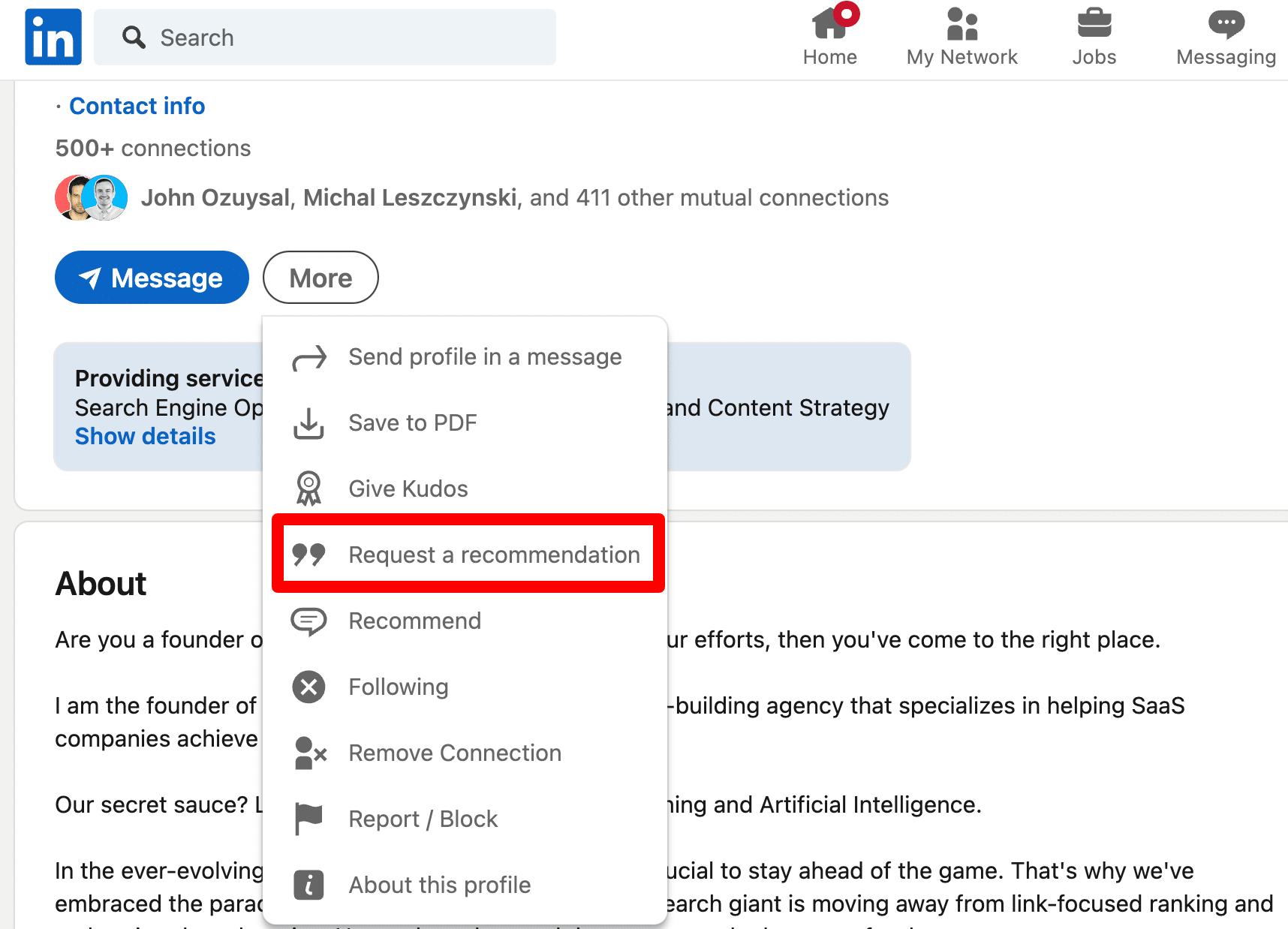
3. Fill in the required information and add a short message.
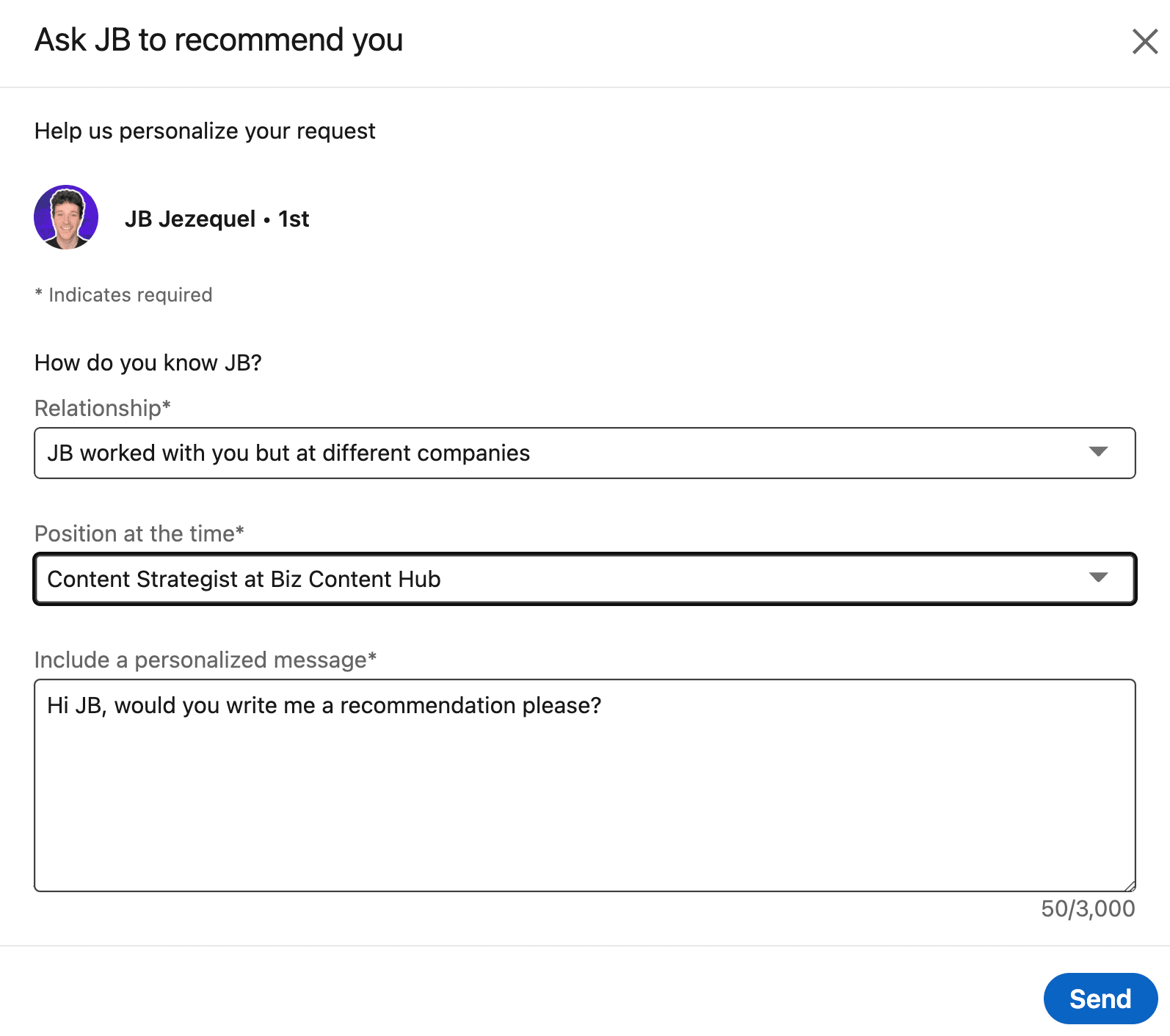
4. Click send, and the recipient will receive a message telling them you’ve just requested a recommendation.
Once you receive your recommendations, you can choose which to prioritize and display on your profile in the Recommendations section.
Consider these suggestions:
- Personalize Request: Tailor each message.
- Be Specific: Highlight relevant experiences.
- Provide Context: Mention the purpose of the recommendation.
- Offer Assistance: Guide on content, if needed.
- Express Gratitude: Always thank afterward.
4. Give Recommendations
Besides asking for recommendations, you can also optimize your LinkedIn profile by giving recommendations.
1. Visit the person’s profile,
2. go to the Recommendations section and
3. click the Recommend [Recipient] button.

Your recommendations will be displayed in a tab next to your received ones, further boosting your profile.
Keep in mind these tips:
- Speak from the Heart: Be sincere.
- Celebrate Qualities: Highlight shared memories.
- Share Stories: Recall meaningful collaborations.
- Keep it Warm: Use a friendly tone.
- Double-Check: Ensure it feels right.
5. Optimize Your Profile for LinkedIn Search
LinkedIn search is a powerful feature that allows users to search for people, companies, jobs, content, and more on the platform.
It is an essential tool for connecting with professionals, finding job opportunities, researching leads, and discovering industry-related content.

A few tips for optimizing your profile for LinkedIn search include:
If you want to become visible, then making your LinkedIn profile search-friendly should be at the top of your list.
- Craft a compelling headline
- Clearly state your job title
- Use relevant keywords
- Write a captivating and detailed summary
- Complete all profile sections
- Highlight your achievements and work experience
- List your skills
Use keywords and language your target audience will likely use in search as you fill out your profile. This makes you show up in relevant searches.
6. Create a LinkedIn Company Page
Creating a LinkedIn company page is a great way to bolster your presence on the platform if you want to sell products or recruit employees.
LinkedIn company pages are dedicated profiles for organizations, businesses, and brands. They allow companies to establish an official presence on the platform to connect with clients, customers, job seekers, and other stakeholders.
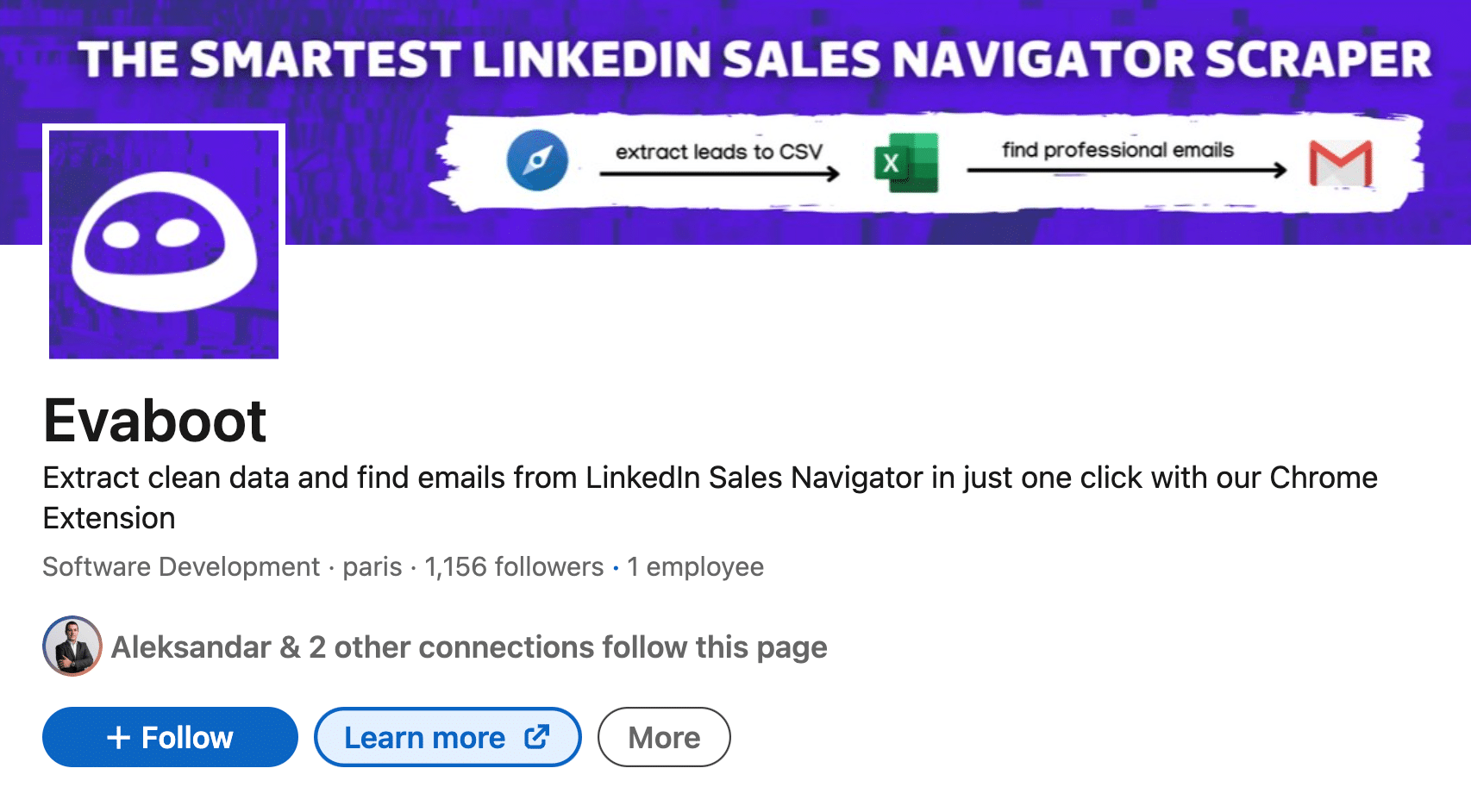
One of the most prominent uses is the job posting feature.
LinkedIn job postings are listings and opportunities employers, recruiters, and organizations post on LinkedIn company pages.
Your job postings will appear on your company page under “Jobs”.
Future employees can create a new job alert and get notified if there is a new position in your company.

2. Be Present
Networking isn’t just about who you know. It’s also about who knows you.
You’re not just using a software tool, you build connections with real people.
Make your presence felt. Stay on your network’s radar and update your LinkedIn status regularly.
Post what you’re reading, or working on, or even a few insights into your personal life.
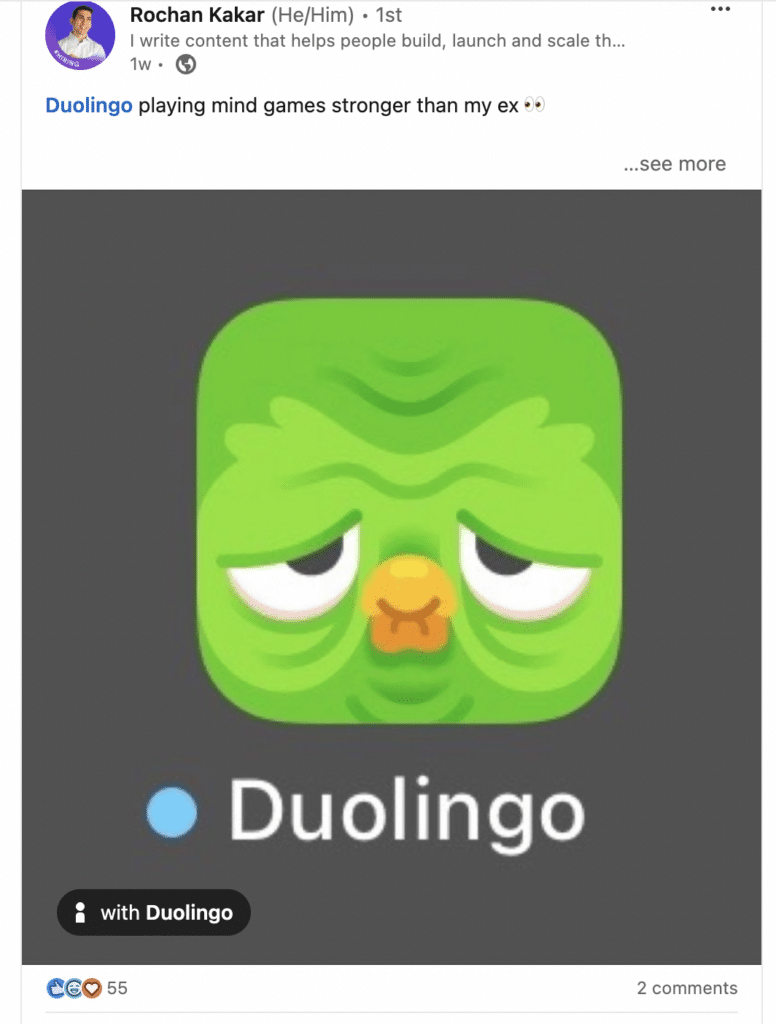
Once you have set a regular cadence for posting, you can take it a step further and start sharing your knowledge and expertise.
Craft helpful LinkedIn posts or articles on your timeline. These will appear in your connection’s LinkedIn newsfeed.
The LinkedIn algorithm favors profiles that regularly create content. Your posts will gradually reach a wider audience, appearing on more newsfeeds.
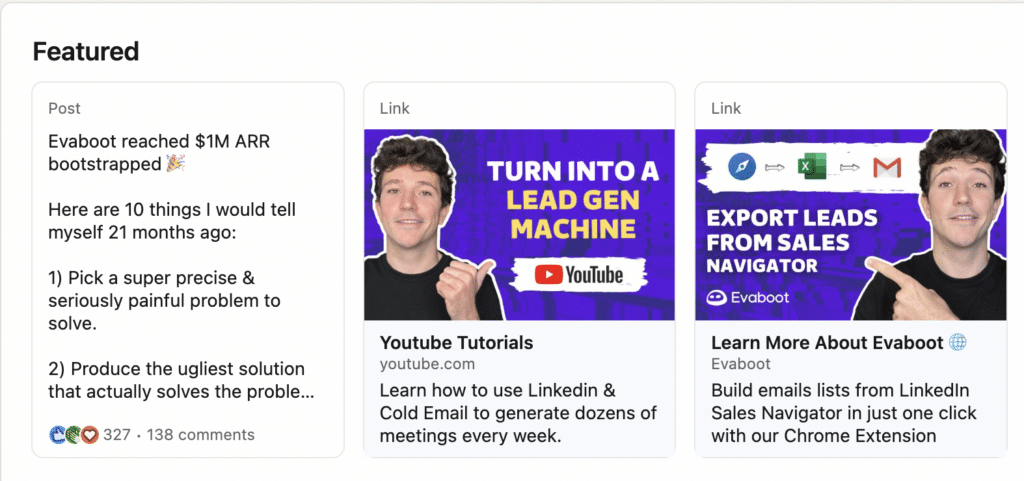
Here are some ideas on what to post on LinkedIn:
- Tips to help your audience solve a common problem
- Trending topics in your industry
- Behind the scenes looks at your processes
- Content to boost your personal brand
Granted, this can be time-consuming.
Plus, you’re never sure if your posts will resonate with your audience.
That’s why I recommend using a tool like Taplio.

Taplio is an AI-powered tool that helps you automatically generate viral LinkedIn posts. It analyzes 4M+ viral posts and identifies top-performing content in your niche.
By discovering what’s working in your industry, you get inspiration for creating your own viral posts. As a result, your LinkedIn content marketing game will be top-notch.
Besides creating great content, you should also:
- Stay active on LinkedIn by posting updates regularly
- Share your contacts’ posts and recommend them
- Engage with other users’ content regularly
- Mention and tag others in your posts
Create such a great presence, that people will complain about missing it if you stop creating it.
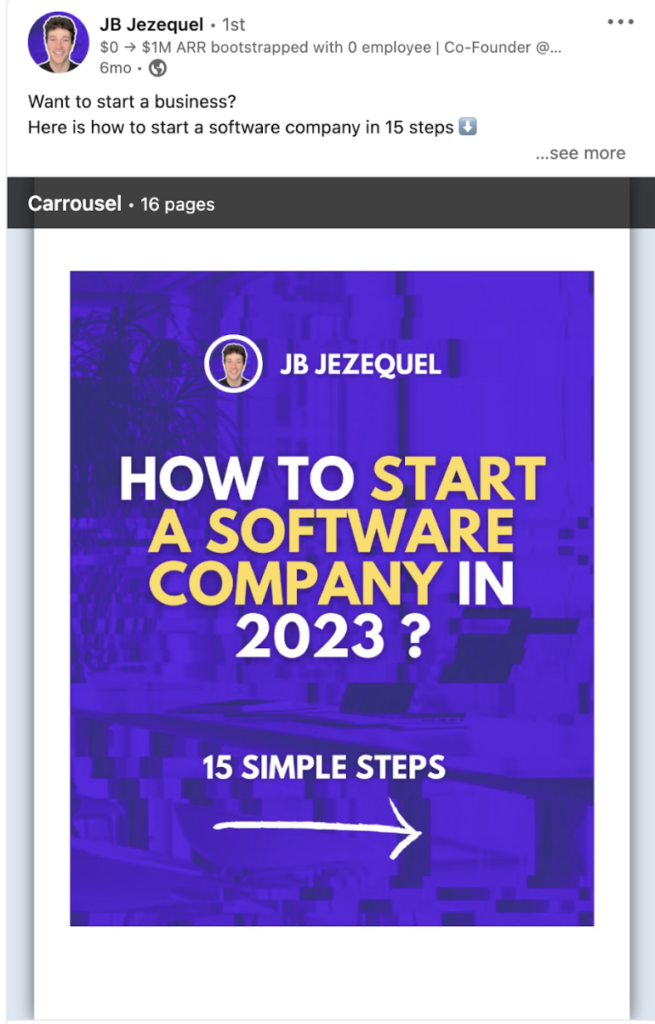
Follow my LinkedIn profile and see by yourself how I gained 30,000 followers on LinkedIn.
We have been able to scale the company from zero to 2 million in just 2 years, making LinkedIn an indispensable part of our acquisition strategy for networking with our target audience.
The content we’ve shared on LinkedIn played a pivotal role in achieving this milestone by attracting and engaging our followers.
3. Leverage your existing contacts
Networking doesn’t just mean reaching out to strangers.
If you’re just starting on LinkedIn, build your network by uploading your online address book (email contacts) and connecting with people you already know and trust.
You can also use LinkedIn’s “People you may know“ section under the “My Network” tab.

Connecting to people in this section is easier as you have some things in common.
One tip for this is to connect to people you can add value to or those who can add value to your network.
For example, if your goal on LinkedIn is to advance your career, then connect to hiring managers, recruiters, or people in the industry you want to work in.

Or, if you’re in sales, connect with potential buyers, brands, and anyone who fits the bill of being a lead.
Another way to grow your network fast is to ask your 1st-degree connections to introduce you to their network. All you have to do is send them a simple, short, concise message.
For LinkedIn has a powerful feature that enables you to extract email addresses from your email account and automatically sync them to your LinkedIn network.
- Go to your Network tab
- Click Show Less:
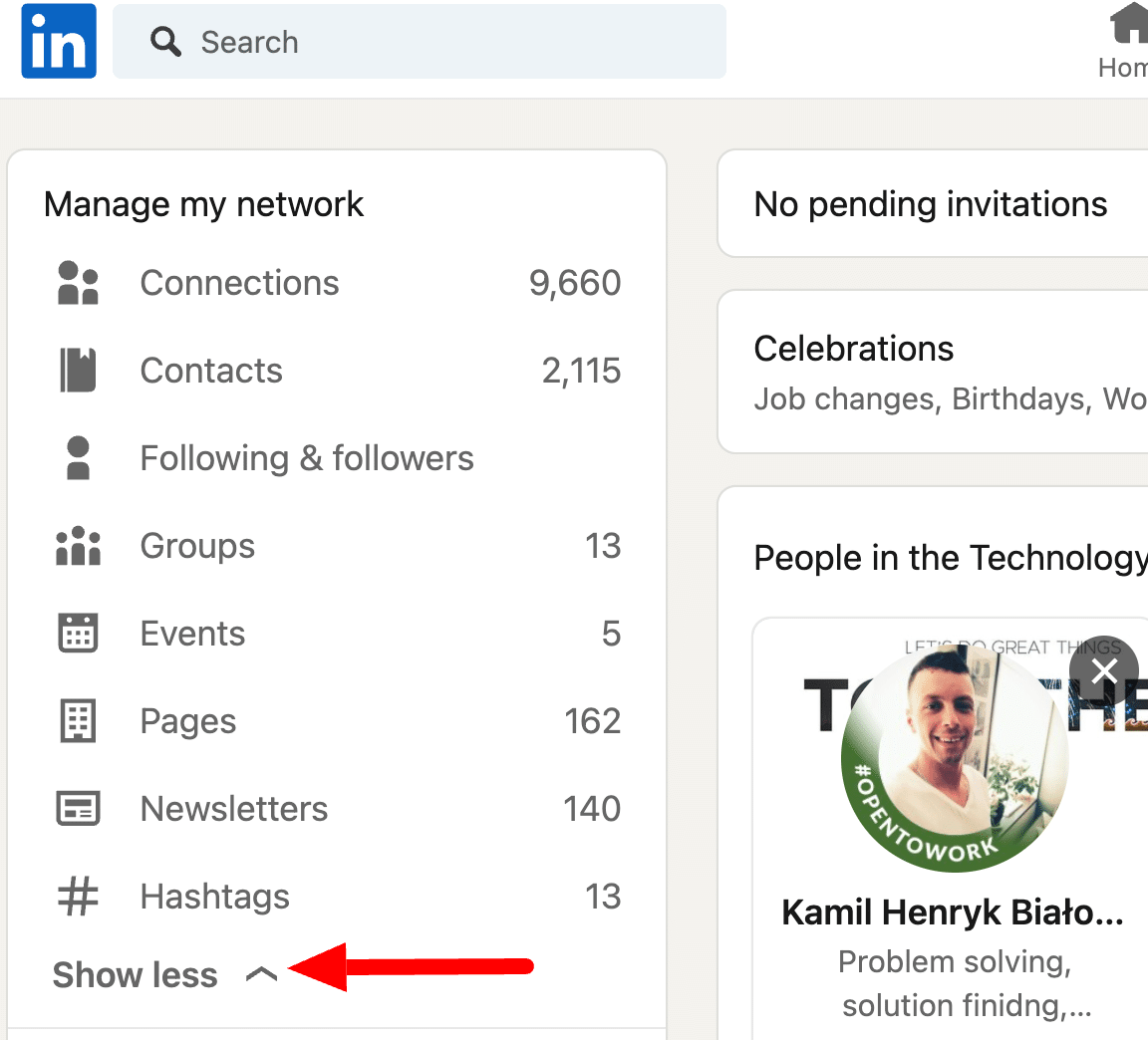
This will reveal a hidden menu. Here, select More Options:

You’ll then be taken to a page with options for syncing your contacts. Click Continue.

Your contacts will be synced, and you can send invites.

These invites aren’t counted toward your weekly connection limit.
4. Join LinkedIn Groups
LinkedIn Groups are online communities within the LinkedIn platform where professionals with similar interests, industries, or expertise come together to network, discuss industry-related topics, share insights, and collaborate.
Your chances of being noticed are increased if you initiate interesting discussions in the groups. Plus, it’s easier to make new meaningful connections with group members as you have a lot of common ground.
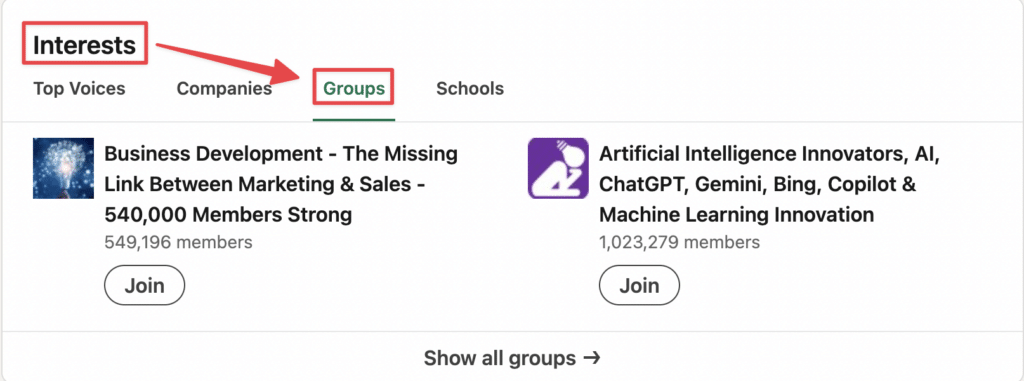
The best part is that there are groups for every industry and niche.
Plus, anyone can leverage LinkedIn groups to their advantage. For example
- Career: Students can get a leg up by reaching out to alumni in their school groups.
- Sales: By strategically connecting with group members, you can prospect in LinkedIn groups, find new opportunities for collaboration, generate leads, and drive sales.
- Recruiting: Recruiters can spot and vet talent in groups by observing content quality and engagement from other group members. This makes it easy to headhunt and increases the chances of finding reliable candidates.
Finding relevant LinkedIn groups is super easy.
1. Simply search for specific keywords related to your industry, interests, or target audience.
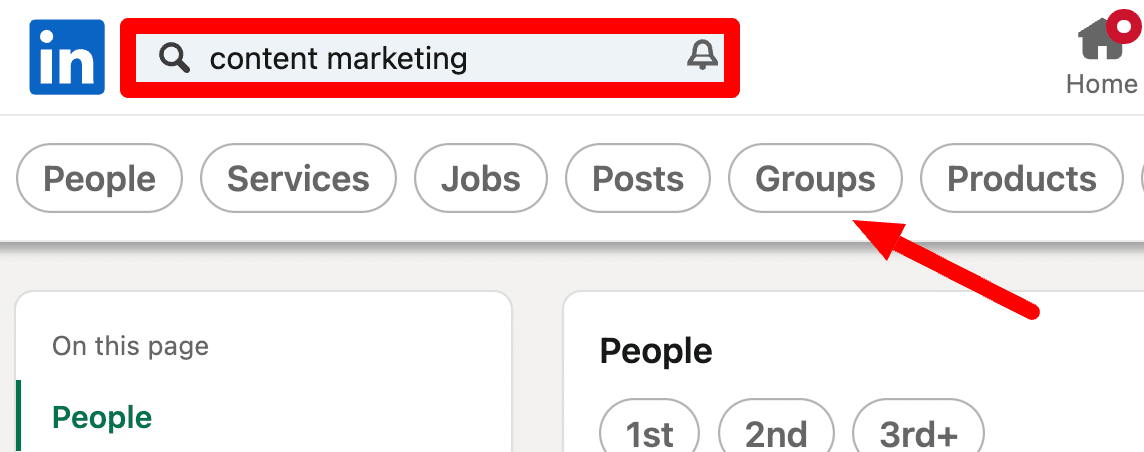
2. Next, click on the Groups option.
This will open a page where you’ll find all the groups related to your search query.
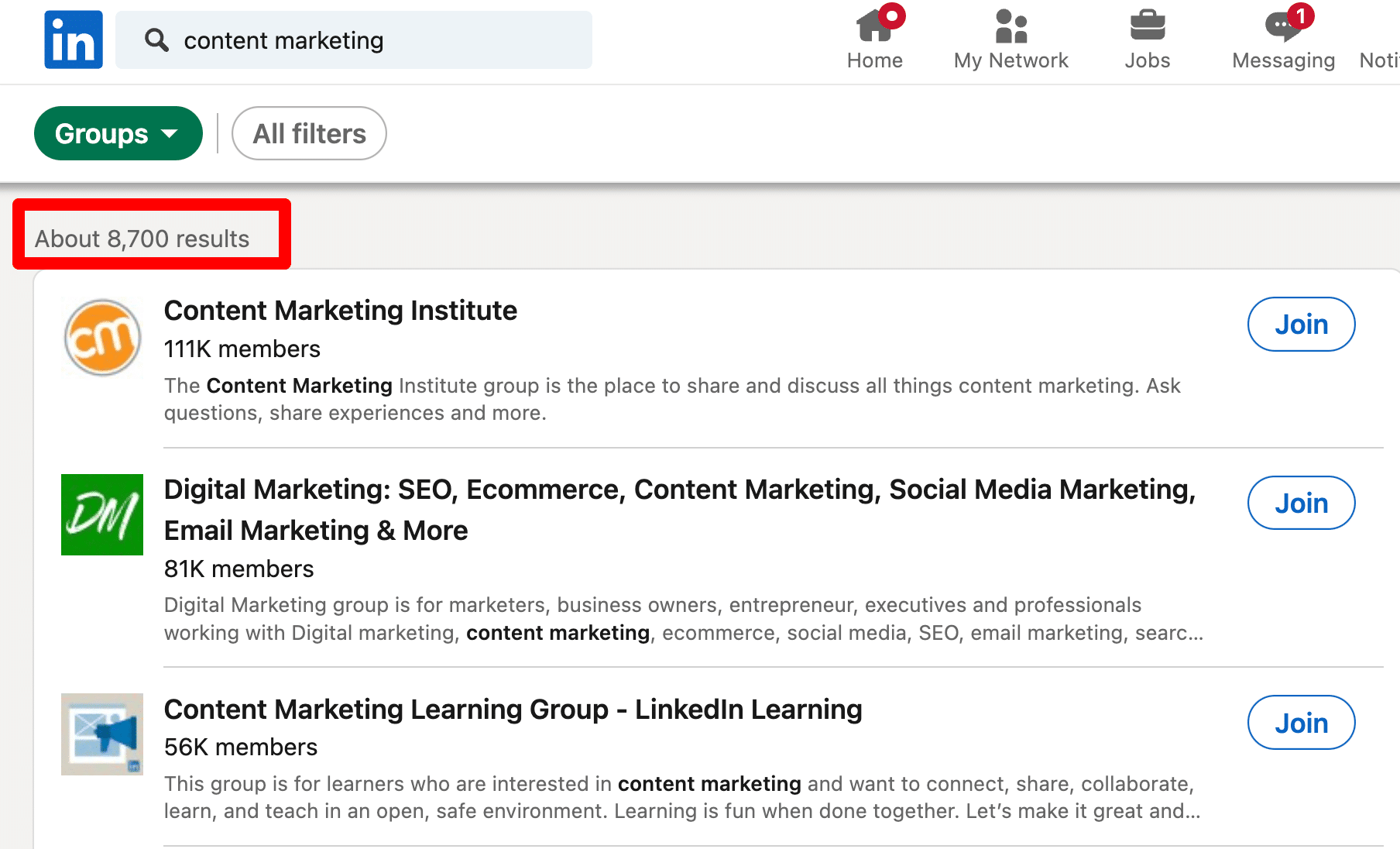
You can also create your own group and build a community. This can be powerful for brands that want to promote their products or events.
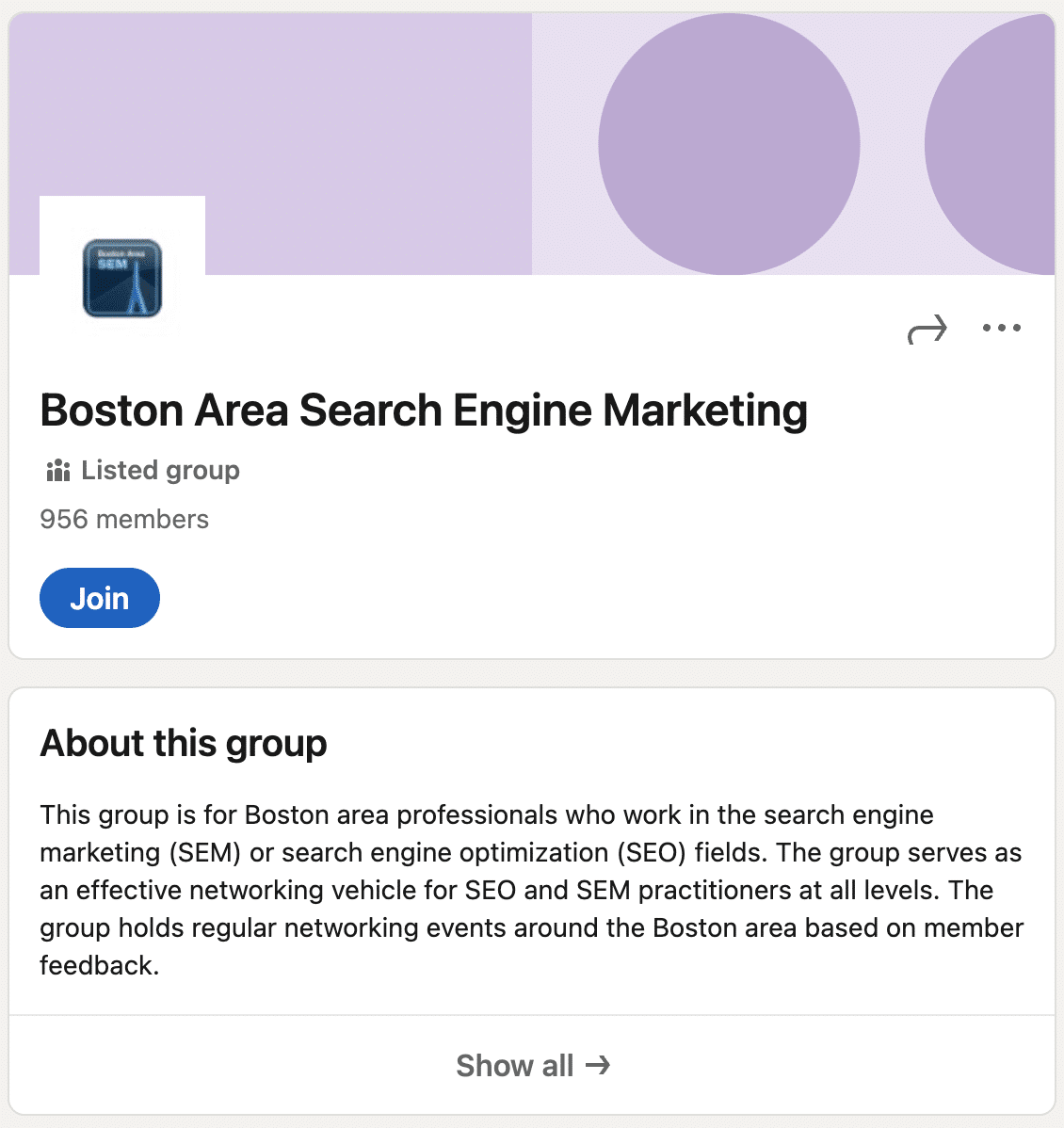
Some even leverage LinkedIn groups to build local communities where you can have in-person meetings, further bolstering your networking.
5. Join LinkedIn Events
LinkedIn Events is a feature that allows you to create, promote, and manage virtual and in-person events.
Examples include webinars, conferences, workshops, networking events, product launches, and other types of events.

If you’re a marketer or sales rep, consider running your own LinkedIn events, as they are a great opportunity to showcase your product and get in touch with warm leads.
To find new clients, we regularly attend relevant events in our niche or of your competitors, then export the LinkedIn event attendee’s information and reach out to them.

It’s such a simple and effective way to reach relevant people. You can refer to the event, have common ground, and you already know what they’re interested in.
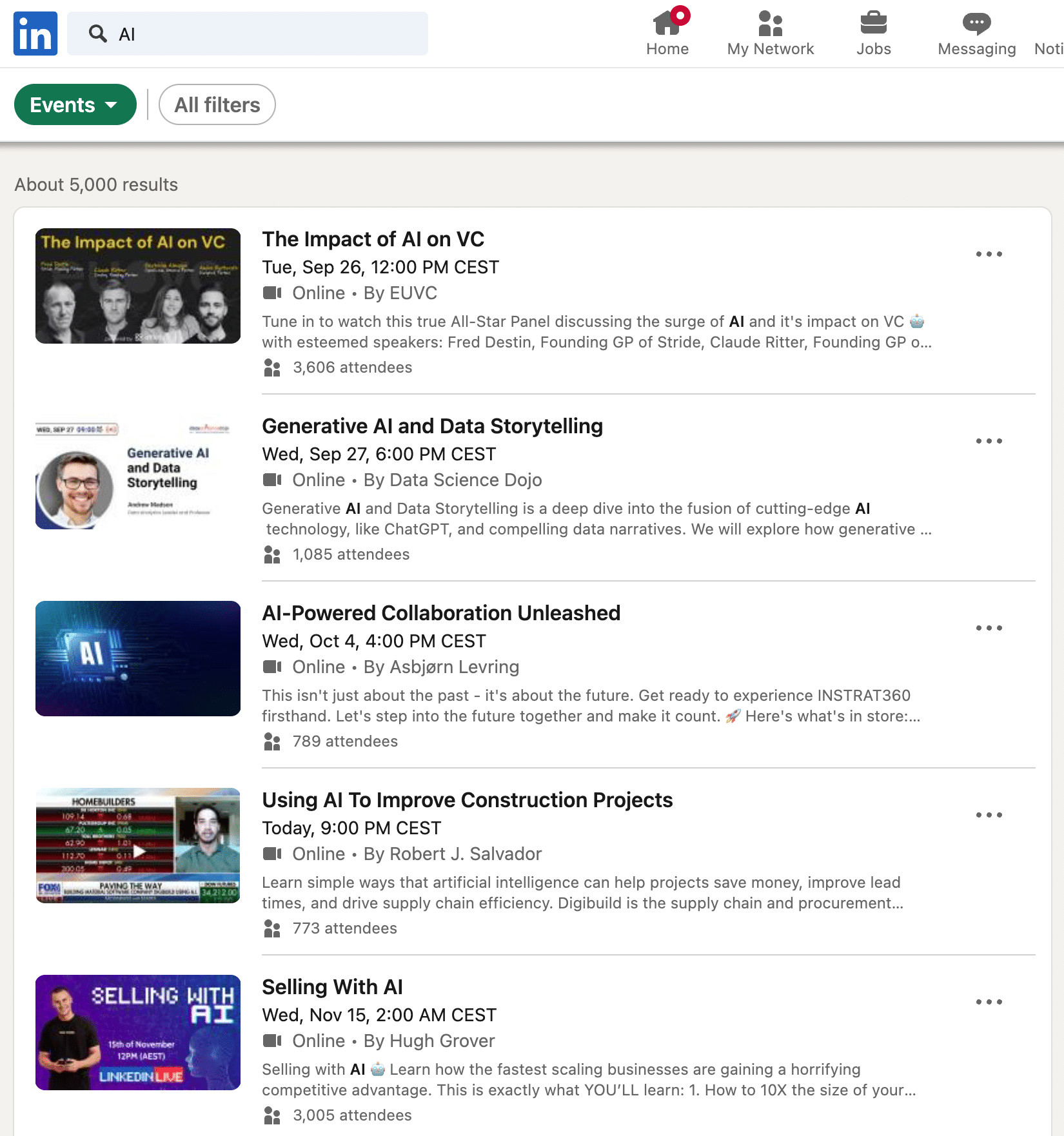
Advance your career and use events to network with people in your field (or future employers if you’re a student).
6. Filter the right people
Build your network strategically and find people who share your interests and have something in common.
If you want to create a network for sales, define your ICP (Ideal client profile) first, then use a filter to find the matching prospects.
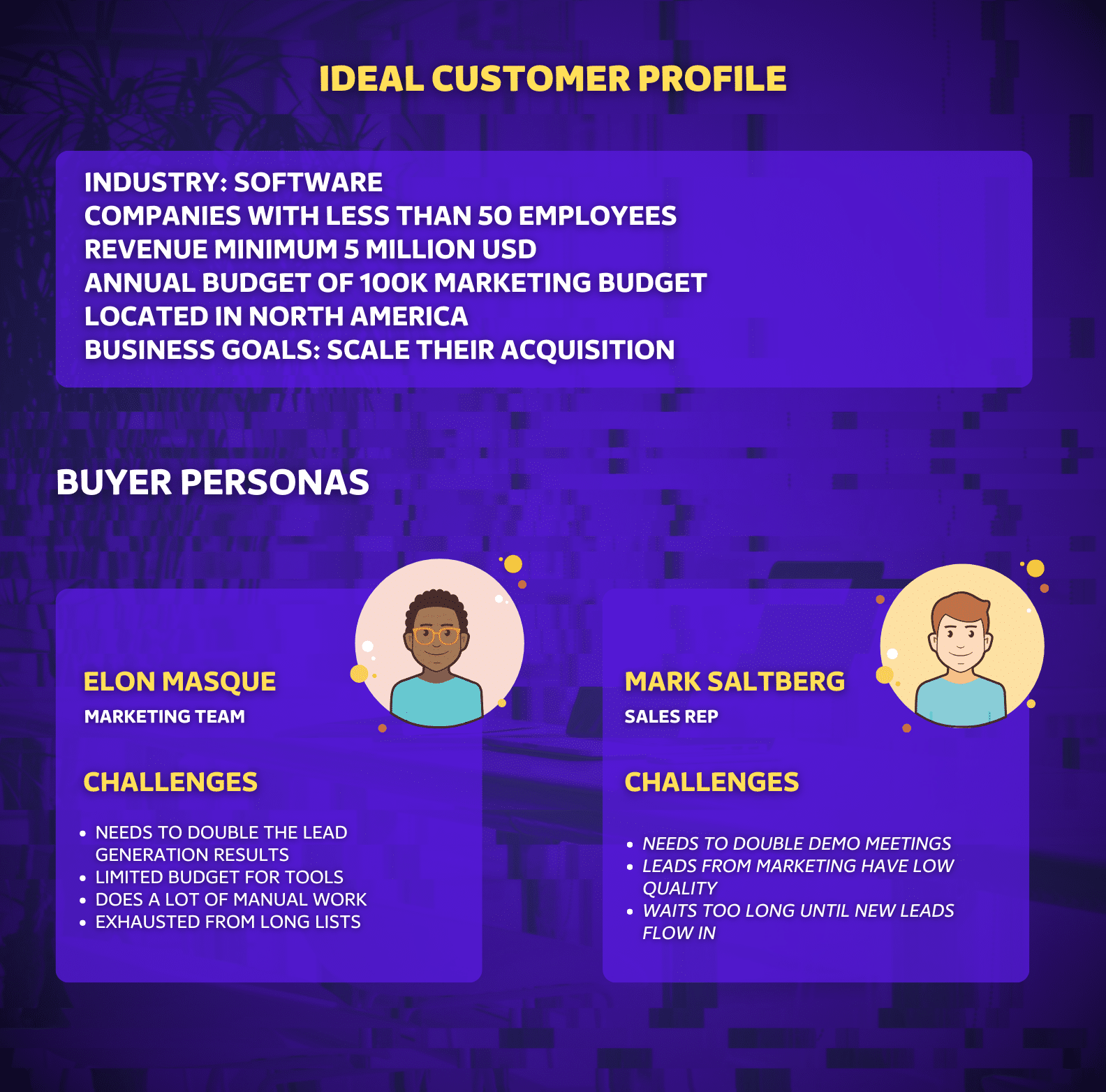
If you’re a student or building your professional network, look for people in similar fields.
You can build highly-targeted networks quickly thanks to the powerful tools LinkedIn provides.
First, you can use the standard version of LinkedIn to search for particular types of accounts using the LinekdIn Boolean search:
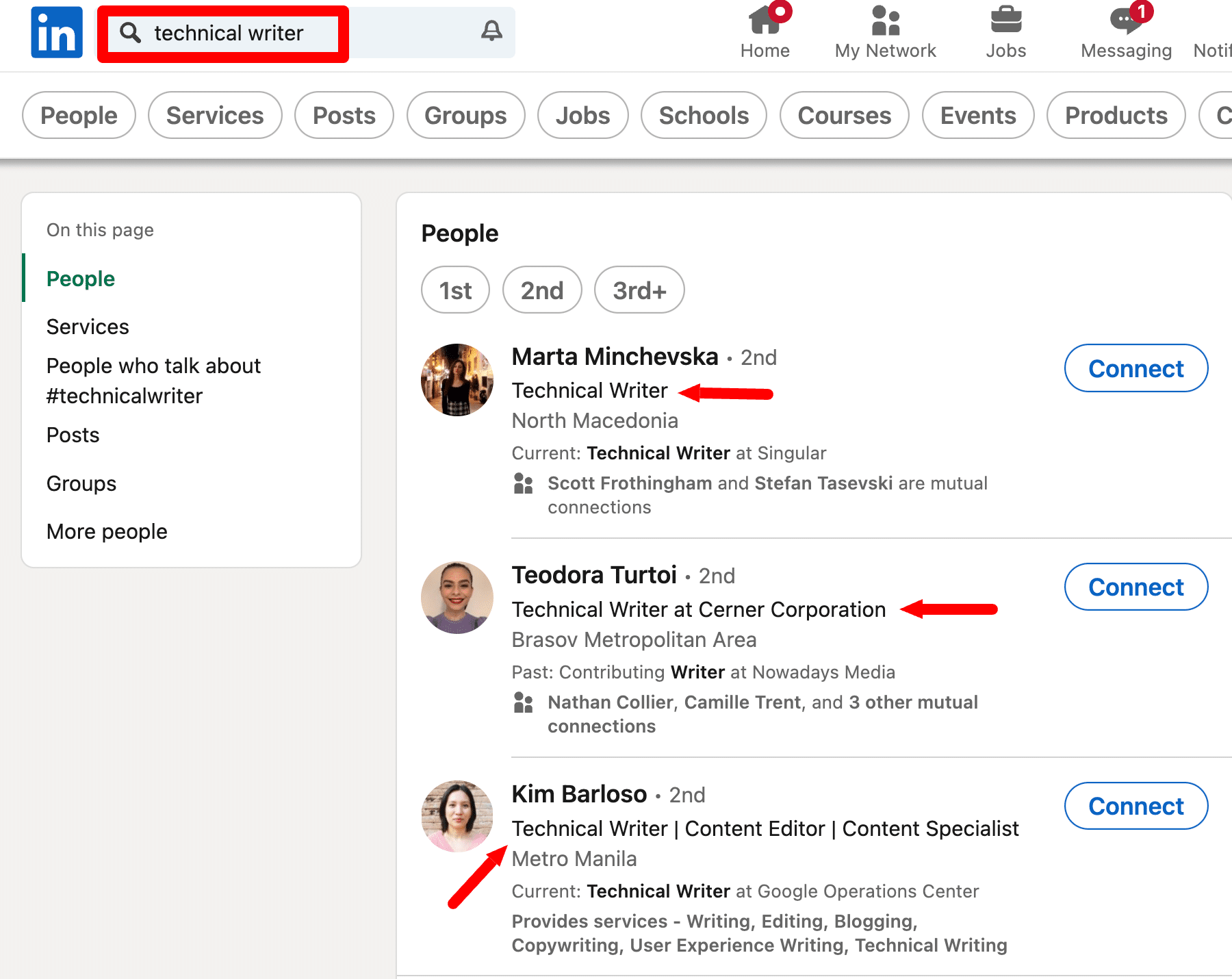
You can then send connection requests to all the profiles that match your preferences.
You can also upgrade to Sales Navigator and unlock more powerful search and filtering features.
This is especially powerful for sales personnel and recruiters as you can save your connections as leads.
Our experience with Sales Navigator has been transformative, allowing us to pinpoint and connect with high-potential leads and prospects more efficiently
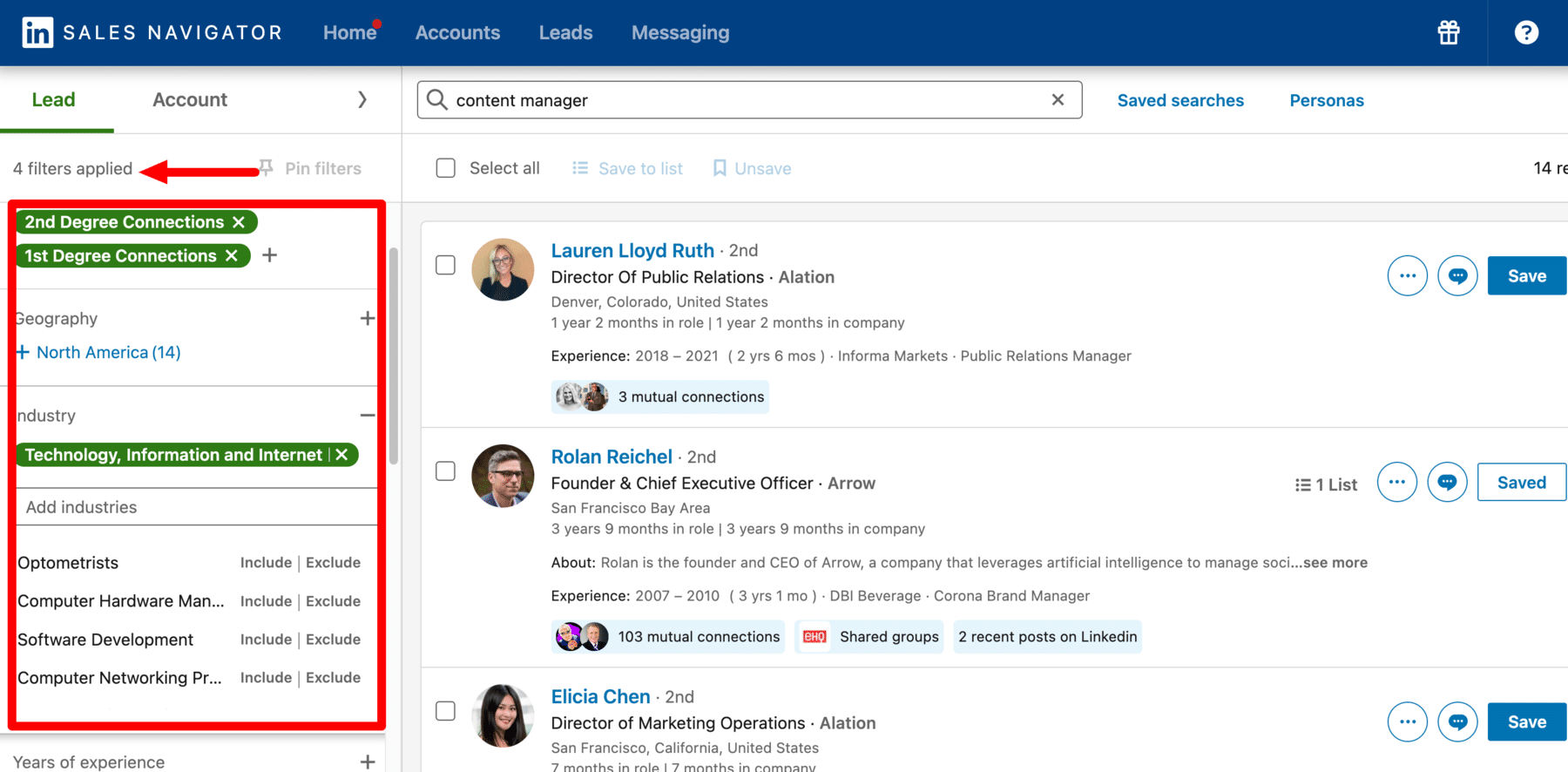
If we were able to find thousands of clients with it, you can do it too!
If you’re a recruiter or hiring manager, then you’ll definitely want to try LinkedIn Recruiter, a premium subscription service designed specifically for talent acquisition.
It’s packed with powerful features to help you navigate the massive talent pool that’s on LinkedIn.

However, if you use LinkedIn for more than just recruiting, I’d suggest you use Sales Navigator, as it, too, works perfectly for recruiting purposes.
7. Send personalized connection requests
If you want to expand your LinkedIn network fast, send personalized connection requests.
1. Open a profile and click on the “More” button, then “Connect.”
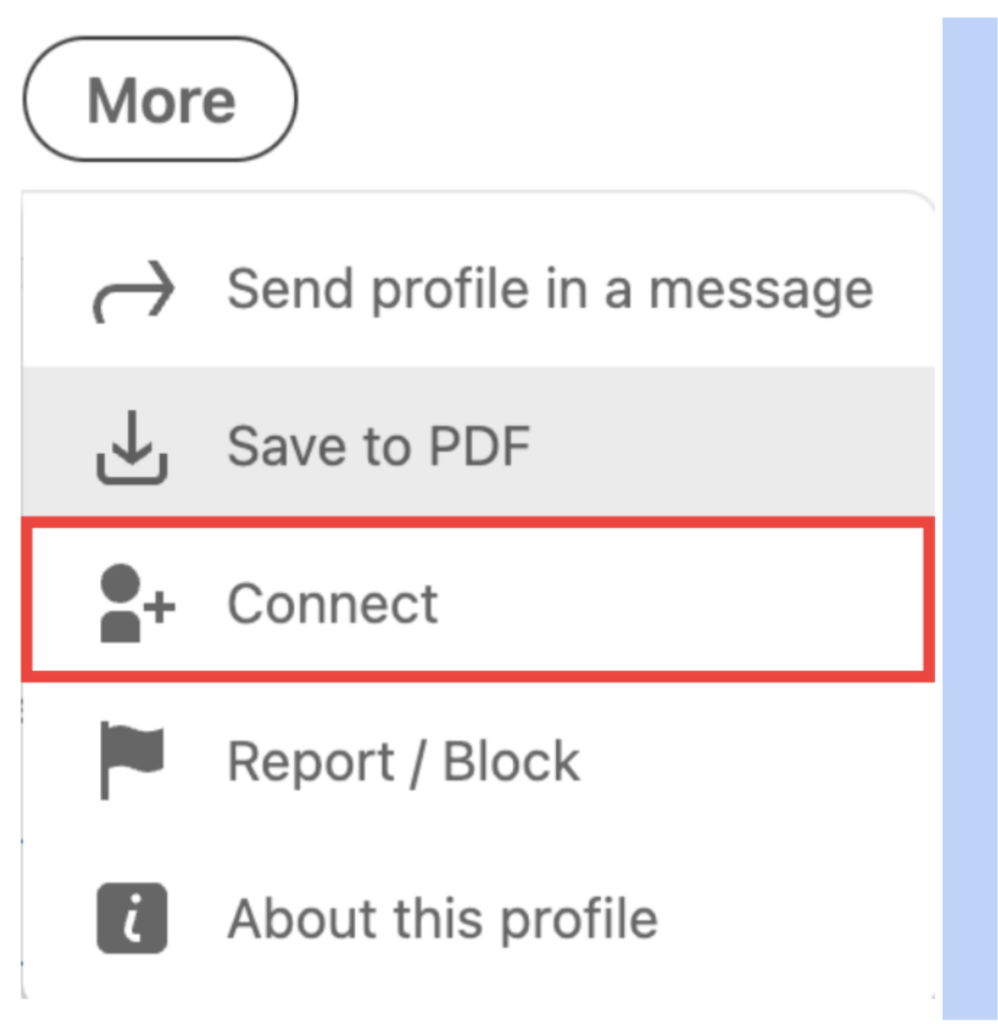
2. You can send a request with or without notes. Just click “Add a note” and add a short connection request with a maximum of 300 characters.
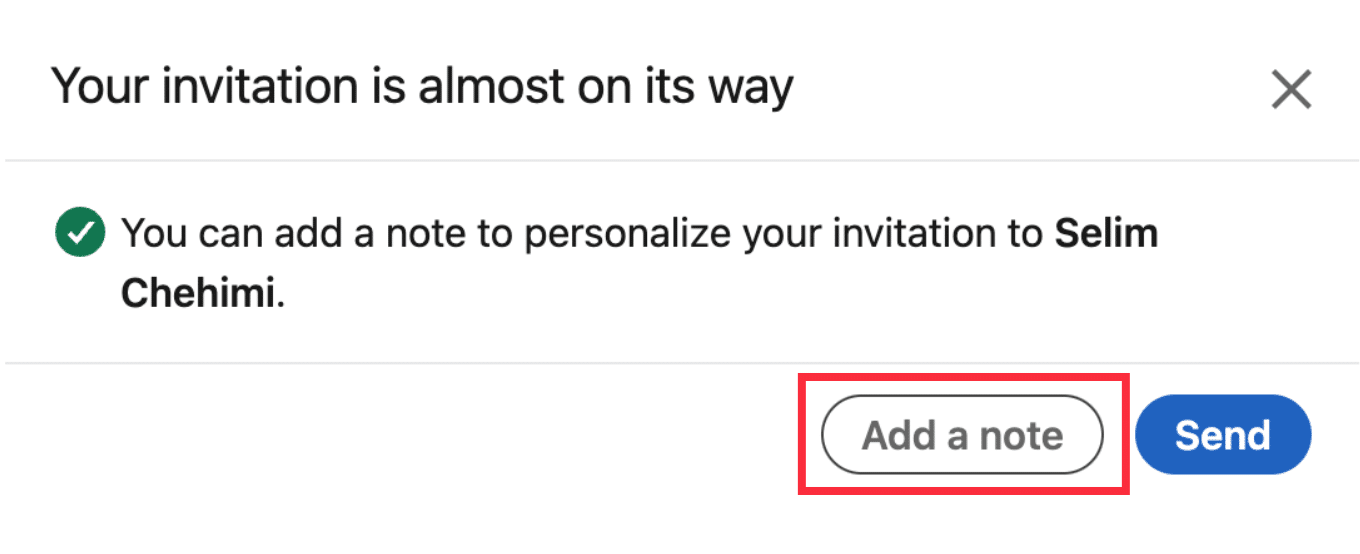
When you add a note to your connection request, it lands in the recipient’s inbox.

However, only add notes to your connection request when it’s relevant.
You can also use InMail, a premium feature, to send personalized connection requests.
The main difference between connection requests and InMail is that InMail is a premium feature that lets you directly reach out to any LinkedIn user without sending a connection request first.

If your request isn’t accepted, you can still send an InMail and bypass the connection request step.
Check out our article on prospecting messages on LinkedIn for more details.
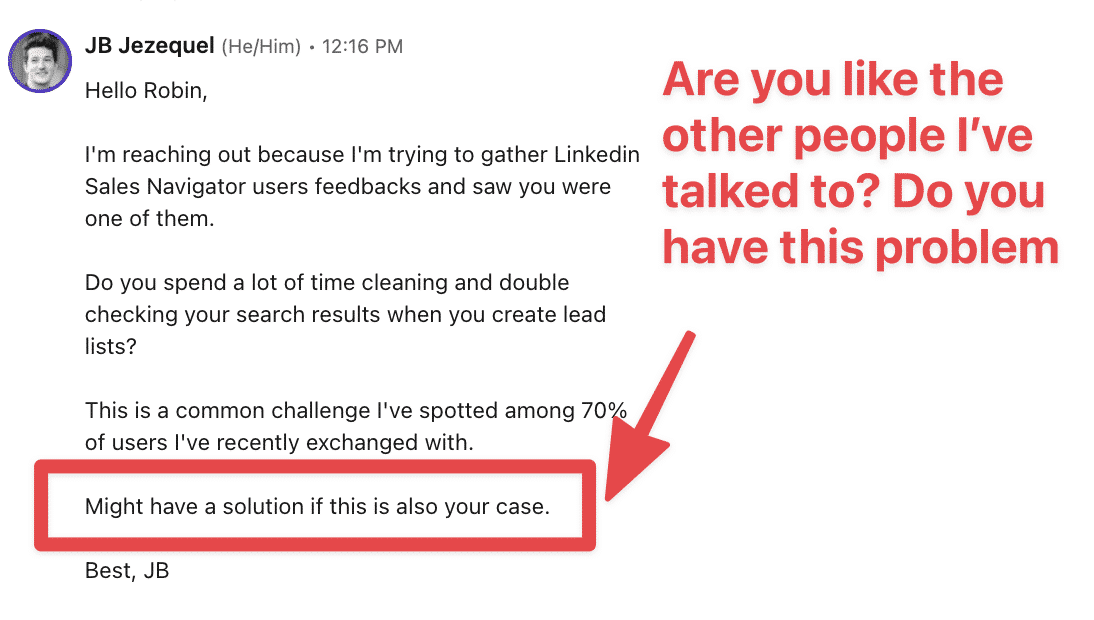
Here’s an example of a personalized note you’d send prospecting on LinkedIn using personalized connection requests.
You can tailor this to suit your needs and requests as a student, recruiter, salesperson, etc.
Stuck on what to say in your personalized messages?

1. Get Personal
Instead of sending generic connection requests or messages, take a moment to personalize your approach.
View their profile, mention a shared interest or a mutual connection, or comment on a recent post or accomplishment they’ve shared.
By getting personal, you show genuine interest and set the foundation for a more meaningful connection.
2. Make it About Them
Shift the focus from yourself to the person you’re connecting with to build relationships.
People appreciate when you show genuine interest in their achievements, goals, or content. By centering your approach on them, you foster a more authentic connection and lay the groundwork for a mutually beneficial relationship.
Consider how you can support your connections and highlight that in your message. Genuine helpfulness often leads to reciprocity; when you selflessly assist others, they are more inclined to return the favor in kind.
3. Endorse them
Skill endorsements are a great way to recognize your 1st-degree connections’ skills. It’s also a great way to encourage new connections to interact with your profile.
Remember, you can only endorse skills already listed on someone’s profile.

Just go to their profile, click on “Skills” and scroll through them until you find a relevant one.
Click on “Endorse”, it will then change to “Endorsed”.
8. Use Automations to Get more LinkedIn connections
Impactful networking on LinkedIn is also a numbers game. The more connections you make, the higher your chances of meeting the right people to further your goals.
If you want to increase your connections exponentially, consider using LinkedIn automation. LinkedIn automation refers to using LinkedIn automation tools to automate various actions and activities.
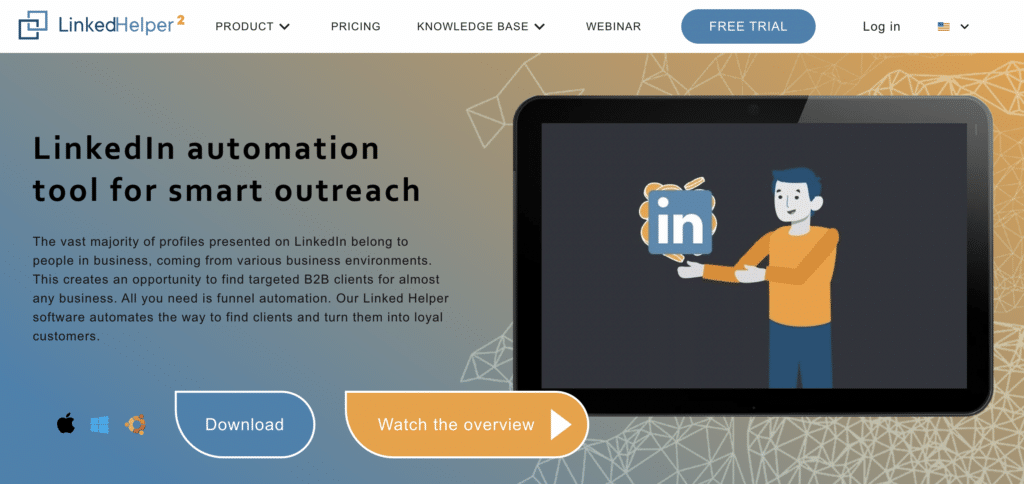
One tool I’d recommend right away is LinkedHelper. It’s one of the oldest LinkedIn automation tools with the best reliability. Plus, it’s one of the most affordable, so it won’t burn a hole in your pocket.
9. Use email to connect
While LinkedIn is a fantastic networking tool, it does have its downsides. One of the most significant downfalls of LinkedIn is its weekly invitation limits.
You get from 100 to 200 connection requests per week.
For serious networking, that might not be enough.
To scale your LinkedIn networking, simply add email outreach to the mix.
This multi-channel approach works wonders as it makes you hard to ignore, especially when you need to follow up on LinkedIn messages.
It also gives you more flexibility as you can bypass LinkedIn’s weekly invitation limit.
In my own multichannel outreach campaign, I successfully reached out to over 2,000 individuals using a structured approach:
- First, I Initiated contact with 2 introductory emails.
- Then, I sent LinkedIn connection requests without additional notes.
- And I followed up with 2 LinkedIn messages.
The results were remarkable: An impressive 55.5% of LinkedIn connection requests were accepted.

A substantial 46% of the contacted individuals replied to the messages, highlighting the effectiveness of this outreach strategy.
The best way is to get a LinkedIn scraping tool like Evaboot to export email addresses and other vital data from LinkedIn to an Excel file.
Install the Evaboot Chrome extension and then a button “Export with Evaboot“ will appear at the top of your lead lists in Sales Navigator.
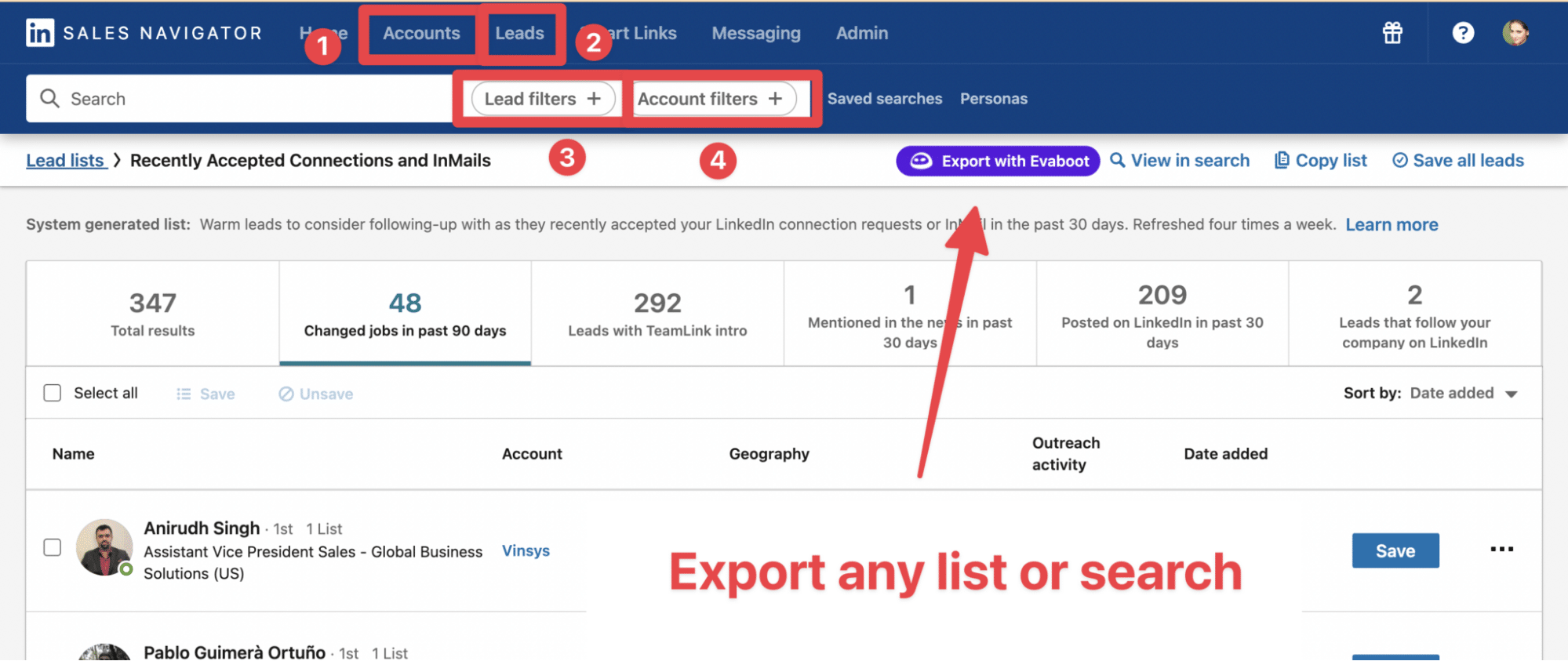
When you click on the button, you’ll be directed to the Evaboot app.
Select if you want to find emails for these leads or not.

Give a name to your export and click on “Export leads”.
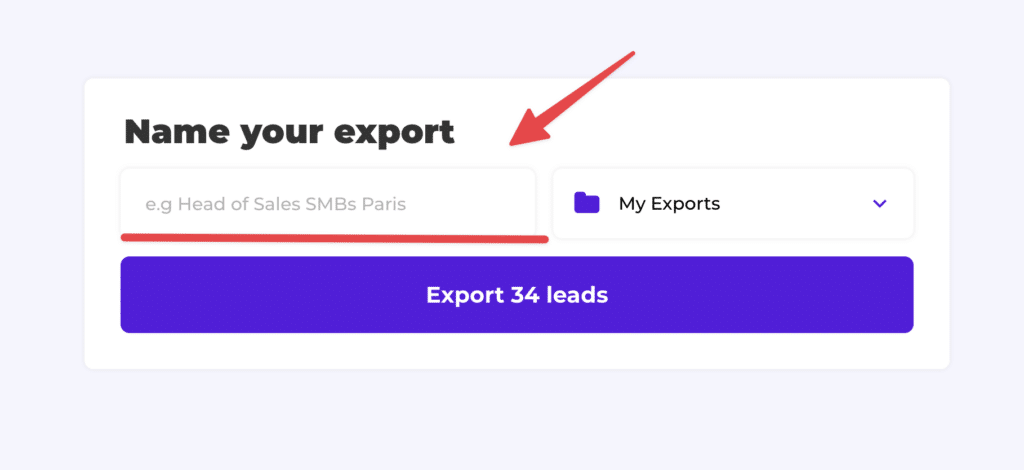
The estimated end date will appear on the left right after launching the export.

Evaboot will export all these leads in real-time.
That makes your lead generation process GDPR-compliant, in opposition to using databases.
Evaboot will then extract the leads in real-time for you.
Once the extraction is finished, you will receive an email notification with a link to download the CSV file containing your lead list.

Choose the list type that you want to download. And you’re done.
Evaboot does much more than export your list. It also cleans all the names and company names of your LinkedIn contacts.
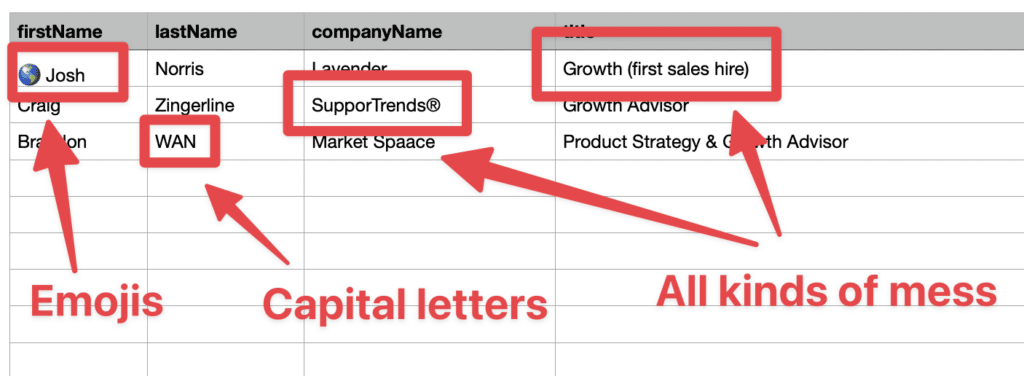
The data on LinkedIn is not clean.
Cleaning data from your sales navigator export can take hours if you do it manually.
Hopefully, the Evaboot cleaning algorithm takes care of all this work for you by automatically cleaning:
- First names
- Last names
- Company names
- Job titles
Nobody wants to spend hours cleaning Excel files. Better let robots do this boring job.
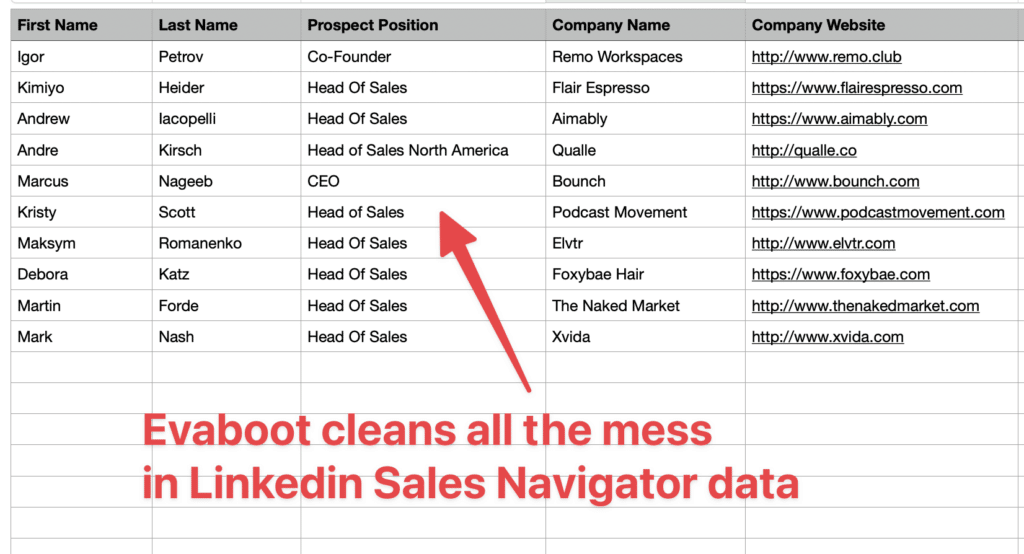
You will often find false positives in your LinkedIn Sales Navigator search results.
Even if you’re using super precise LinkedIn search operators.

You will frequently find leads that don’t match the search filters you chose in the Sales Navigator search engine.

That’s why many people spend hours double-checking their search results manually. This is a painful task, but it’s no problem.
Evaboot is the smartest Sales Navigator scraper because our algorithm double-checks your leads to ensure they match your selected search filters.

This export has a column named “No Match Reasons.” This column tells you if your leads match your search filters.
If they don’t, we will explain why. In this example, the leads have the wrong title. The initial search was for growth marketers.
If you want to know how to reduce the number of false positives in your Sales Navigator searches, you can use our complete Sales Navigator tutorial.
Once you have your leads, upload them to an email outreach tool like Emelia. Emelia is an affordable yet capable tool for automating cold email campaigns.
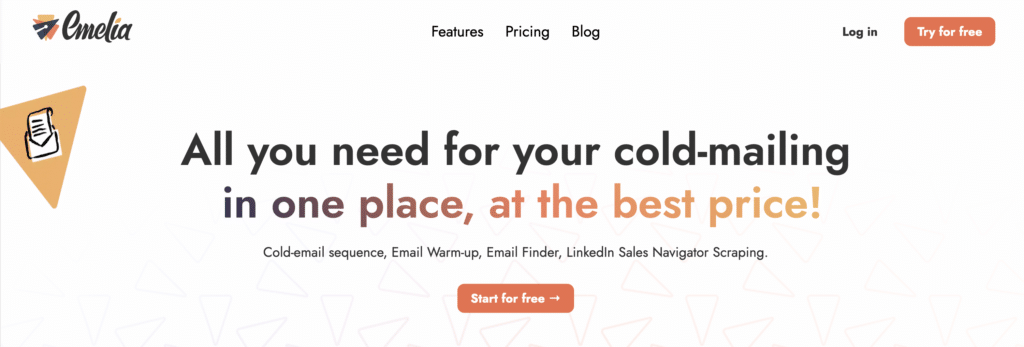
It has an intuitive interface, analytics dashboard, and more.
With your leads uploaded to Emelia (or your outreach tool of choice), you can now ask for a connection via email.
Here’s an example:
Outreach email example
Hey,
Your impressive profile on LinkedIn and your expertise in [Job] at [Company] caught my eye.
The reason for my outreach today is to explore [Specific Topic or Challenge] further.
In your role, you must have come across various [Related Issue/Interest], and I’d love to hear your insights on this matter.
If this resonates with you, I’d be delighted to connect and discuss this further.
I created this template on the RABT Formula and achieved a 25% reply rate.
Check out my post on multichannel outreach to learn more about this approach and other hacks.
The combination of LinkedIn networking and email outreach will result in the phenomenal growth of your LinkedIn and business network.
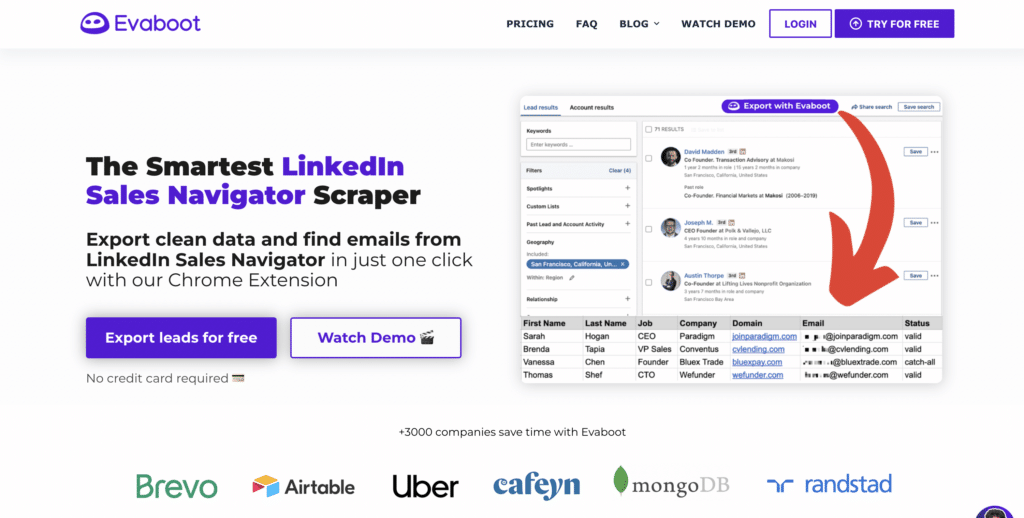
Ready to level up your LinkedIn networking?
Evaboot is your secret weapon.
Sign up to Evaboot, download the Chrome extension, and easily export LinkedIn data, bypassing connection limits.
What to Avoid When Networking on LinkedIn
With our experience working with thousands of LinkedIn professionals, we’ve distilled the best tips on what to avoid when networking on LinkedIn.
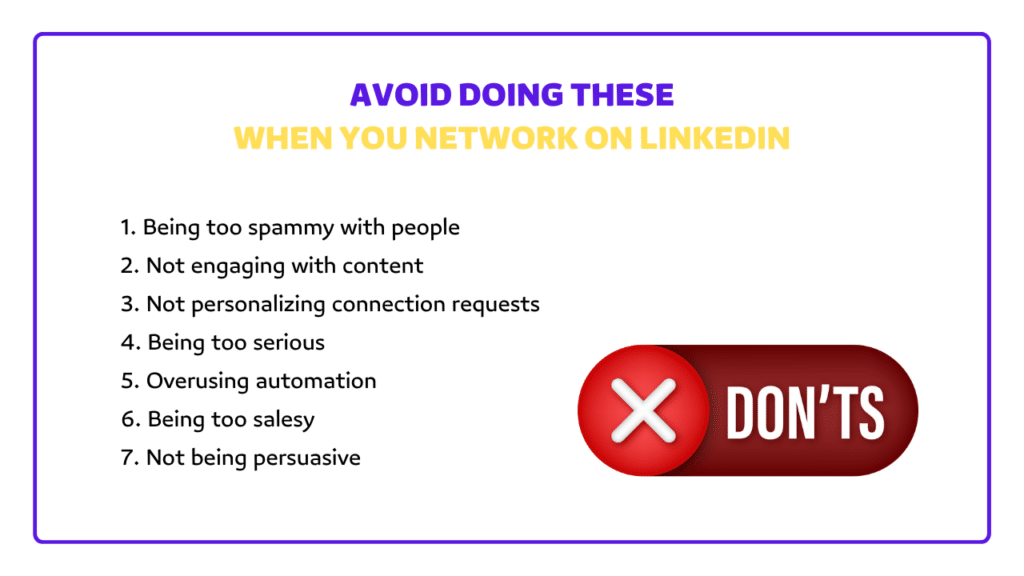
If you want to grow your LinkedIn Network never do these:
- Being too spammy with people
- Not engaging with content
- Not personalizing connection requests
- Being too serious
- Overusing automation
- Being too salesy
- Not being persuasive
1. Being too spammy with people
Spamming on LinkedIn refers to sending unsolicited, irrelevant, or excessive messages. It also involves other bad practices like hijacking posts in the comment section.
Spamming can hurt your reputation, lead to LinkedIn jail, or even be banned from the platform.
2. Not engaging with content
Networking requires effort, especially putting effort into engaging with others’ posts.
Not engaging with content results in you being invisible. It paints a picture of you as being anti-social or bad at communicating.
3. Not personalizing connection requests
For better results, personalize messages when sending connection requests.
Simply study the user’s profile and find common ground. Make sure your message is short and sweet.

However, sending a connection request without a message is also okay.
4. Being too serious
Sure, it’s a professional platform. But that doesn’t mean you should always be serious. Instead, be humorous.
This makes you more approachable.
5. Overusing automation
Automation is a time-saver.
However, don’t rely heavily on it, as LinkedIn discourages it. Overuse of automation could land you in LinkedIn jail.
6. Being too salesy
Avoid being too salesy. Nobody likes being sold to.

Instead, put your network’s needs and interests first. Let the value you provide do the selling.
7. Not being persuasive enough
Don’t be afraid of being persuasive as you interact with your LinkedIn network.
Show them the value and benefits of your offer. Once they see what’s in it for them, it becomes easier for you to win them over.
Conclusion
LinkedIn is the future of networking.
With its vast professional reach, you can build meaningful connections, reach out to people, and find countless job opportunities to advance your career.
In short, LinkedIn is essential for every professional.
FAQ
Is it good to network on LinkedIn?
Yes, networking on LinkedIn is highly beneficial for personal and professional development. With the rise of remote work, LinkedIn has become a key player in replacing traditional in-person networking, giving you a wider reach and more opportunities.
With over 1 billion users in 200 countries, LinkedIn offers endless networking opportunities.
This platform allows you to expand and deepen your social connections, share knowledge, gain inspiration, find support to achieve your professional goals, or even grow your business.
How can I get LinkedIn connections?
Building your LinkedIn network connects you with alumni, colleagues, recruiters, and new professional opportunities.
To get started, you need a primary email address to send invitations.
When someone accepts your invitation, they become a 1st-degree connection and can see your profile information.
LinkedIn limits 1st-degree connections to 30,000 to ensure a quality site experience.
Here’s how to connect with people on LinkedIn:
- From a member’s profile: Click or tap the Connect button.
- From search results: Click Connect next to the member’s details.
- From the Grow Your Network page: Import contacts by their email address.
- From the My Network page: Accept pending invitations.
- From suggestions for people, you might know: Click or tap Connect under the member’s name.
- Leverage existing connections: Ask mutual connections to introduce you, or send a message to your network to find a link to a 2nd-degree connection.
If your invitations are frequently marked as spam, your account may be temporarily blocked from sending more.
When sending a connection request, you must specify how you know the person. If you don’t know them, LinkedIn may ask you to send a message first, possibly as an InMail, depending on their messaging settings.
How many LinkedIn connections are ideal?
Standing out on LinkedIn doesn’t require overwhelming effort.
Currently, 54% of LinkedIn users have fewer than 500 connections, 27% have between 500 and 999, 12% have between 1000 and 1999, and only 3% have between 2000 and 2999.
Adding 400 new connections monthly can reach the top 3% of users in just over 7 months.
How can I use LinkedIn to network with recruiters?
To effectively network with recruiters on LinkedIn, follow these tips:
- Firstly, optimize your profile and make sure it matches the role you’re looking for.
- Update your LinkedIn account to ensure it reflects your current skills and experience.
- Next, target recruiters and hiring managers and reach out to them with a well-written connection message and your pitch.
- Use the “Open to Work” feature to signal your availability.
- DON’T send unsolicited resumes; wait for recruiters to request them.
- DON’T ask vague, open-ended questions; be specific in your requests.
- Be specific in your messages, clearly stating your intentions and goals.
Is it bad to connect with people on LinkedIn you don’t know?
When using LinkedIn, avoid connecting with strangers. Consider LinkedIn as a significant networking event.
You wouldn’t distribute your information to everyone you meet in person, and the same caution applies to online networking.
However, you can connect with second —and third-degree connections, friends of your friends, who may be valuable additions to your network.
Should I let random people connect with me on LinkedIn?
Accepting connection requests on LinkedIn should be done with care. First, consider the relevance of the connection. Next, check to see if you have any connections in common. You should also be aware of red flags.
LinkedIn recommends that you only accept connection requests from people you know personally and trust professionally. While this may seem restrictive, there is value in carefully expanding your network beyond this circle.
Can someone see if I check them on LinkedIn?
When you view someone’s LinkedIn profile, they usually receive a notification unless you or they are browsing in private mode. In private mode, other LinkedIn members won’t know you’ve visited their page.
In that case, other LinkedIn members won’t know when you visit their page.
How do I network with someone on LinkedIn if I don’t know anyone?
Start by connecting with people you know personally.
Next, join groups and interact with members. This will help you find and attract connections you can relate to.
When you send a LinkedIn connection request to someone you don’t know, you will be asked how you know the member. If you select “We don’t know each other,” you must send a message first to establish a relationship.
Depending on their messaging preferences, this may involve sending an InMail.
Disclosure
This content was partly written by AI (ChatGPT 4), I added my own perspective, fact-checked it and made sure it is helpful for you.




![The 35 Best LinkedIn Automation Tools in [year] [Free & Paid] 212 linkedin automation tools](https://evaboot.com/wp-content/uploads/2023/02/linkedin-automation-tools-768x432.png)

![How To Become A LinkedIn Influencer In 9 Steps? [year Guide] 214 how to become linkedin influencer](https://evaboot.com/wp-content/uploads/2022/11/how-to-become-linkedin-influencer-2-768x432.png)
![LinkedIn Groups Best Practices For Your Business [[year] Tips] 215 linkedin groups best practices](https://evaboot.com/wp-content/uploads/2022/11/linkedin-groups-best-practices-768x432.png)
